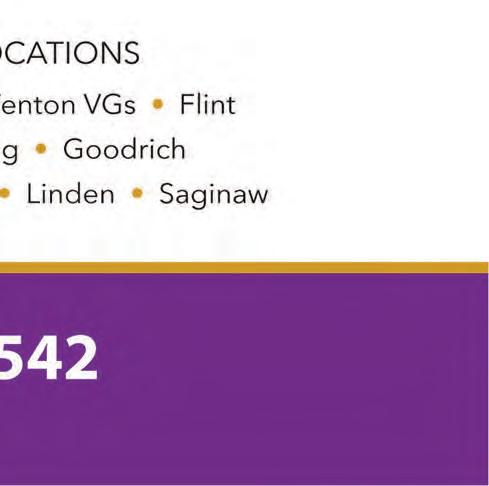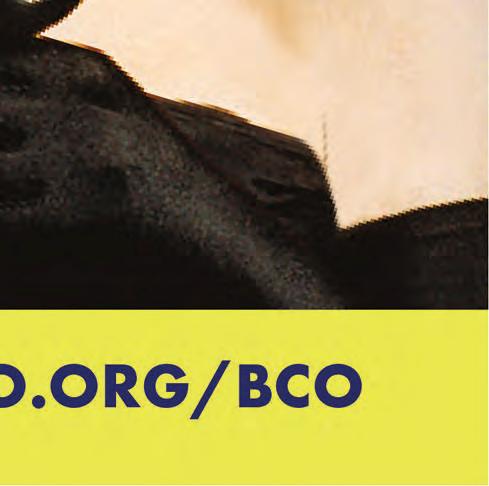

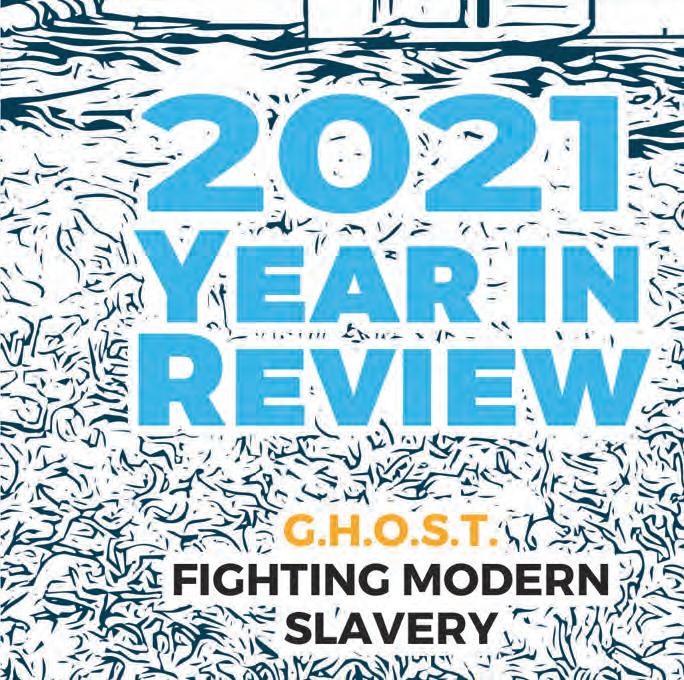






































RYAN J. REECE, MD, FACEP
PHOTO BY DOUG PIKE, HURLEY MEDICAL CENTER
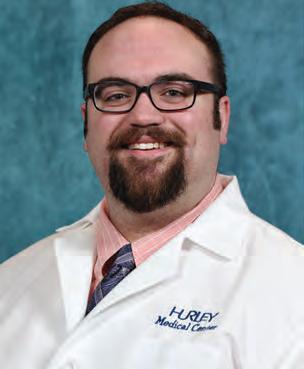
Hurley now o ers a Medication for Opioid Use Disorder (MOUD) clinic to treat those who need help with opioid use disorder. Services are available to patients who are seen in Hurley’s ED who are seeking treatment for their opioid use disorder (OUD), self-identify as having a problem with OUD, withdrawing from opioids or with other complications of their disease or who may have experienced a nonfatal overdose.
e MOUD clinic provides telemedicine care and is led by Dr. Ryan J. Reece. Dr. Reece attended Michigan State University’s College of Human Medicine and completed his residency at Michigan State University/Sparrow Health System in emergency medicine. He is board-certi ed in Emergency Medicine and is working toward his certi cation in Addiction Medicine.
e ED is often the primary source of medical care for individuals with OUD. ED visits o er an opportunity to access life-saving treatment. Identifying individuals with untreated OUD enables providers to motivate individuals to accept treatment, e ectively treat opioid withdrawal symptoms, initiate evidencebased treatment, refer individuals to ongoing care and to reduce harm by o ering overdose education and dispensing naloxone kits.
• Consultation with an ED social worker
• Telemedicine appointments
• Medication
• Referral to New Paths, Inc. a local substance use disorder treatment program
• Facilitates safer withdrawal by relieving symptoms and controlling cravings
• Reduces the risk of death due to overdose
• Increases retention in treatment with safer, controlled medications
• Works to decrease illegal drug use and, with it, the potential dangers

Instead of understanding addiction as only a moral or spiritual failing, many medical professionals have begun to view opioid use disorder as a medical disease. e disease of addiction can be caused by repeated exposure to a drug, coupled with genetic or environmental risk factors, leading to physical changes in the brain’s opioid receptors. In this view, addiction can be treated and managed with medication, much like other chronic medical conditions. Medication has been shown to provide an evidence-based, safe, controlled level of treatment to overcome the use of a problem opioid. Hurley’s program o ers a safe, comfortable environment for patients who su er from OUD.
Dr. Reece notes, “ e MOUD program uses a very collaborative approach. e ED social workers, providers and nurses all play a huge role in helping this population receive much needed treatment. It provides another tool to help this population.” ®

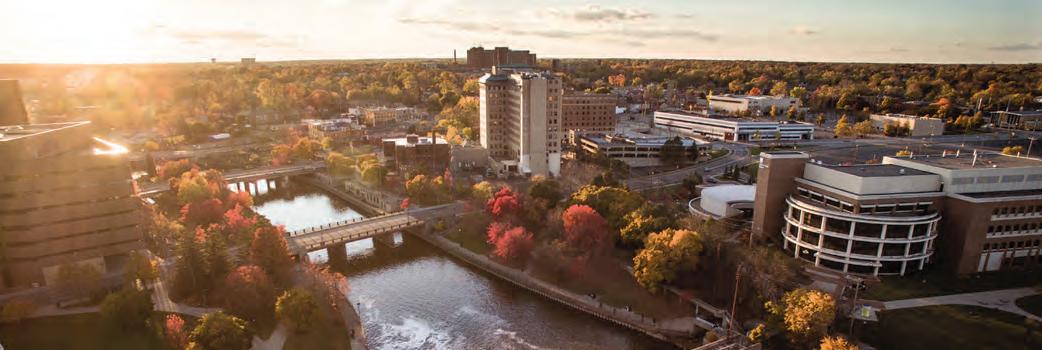
Happy New Year!
What a di erence a year makes – or at least, it feels a little di erent. MCM started to look familiar again starting in August ‘21, when the summer “Haps” returned to infuse Greater Flint with some much-needed fun with fellow citizens. e magazine just wasn’t the same for so many months without any pages full of smiling faces. At this writing, there are murmurs of more lockdowns coming … time will tell.
Once again, we capture the highlights of MCM’S 2021 volume with our annual “Year in Review” section, highlighting many of the memorable stories we shared with you. Maybe you missed one or two – that starts on p.18.
Of the many types of stories found in each issue, we’re always happy to feature local businesses that give back. Last November, the Flint & Genesee Group presented the 7th Annual Art of Achievement Awards, and among the winners was Great Harvest Bread Co. Read about this deserving award recipient on p.12, and look for more winners to be pro led in the months ahead. Unfortunately, we’ve been compelled to do many features about serious and troubling issues, including what is known as modern slavery. January is National Slavery and Human Tra cking Prevention Month, so we chose to shed light on G.H.O.S.T., a task force within the Genesee County Sheri ’s O ce that was created to ght these heinous crimes. Read about Sheri Swanson’s success with this e ort starting on p.8.
Rounding out the content this month, we have great variety in our Arts, Music and Sport pieces, as well as part one of a new history series, “ e Mayors of Flint” and the monthly o erings of our contributors.
Being a “glass half-full” kind of guy, I’m going to end on a note of hope that we can all leave the struggles of 2021 in the rearview mirror. Begin this New Year with positive energy and prayers for good health, peace and prosperity. Let’s make it happen! anks for reading,


&
PUBLISHER & EDITOR IN CHIEF
Vince Lorraine
MANAGING EDITOR
Sherron Barden
ASSISTANT EDITOR / WRITER
Peter Hinterman
STAFF WRITER
Cheryl Dennison
FREELANCE WRITERS
Mark Spezia
CONTRIBUTING WRITERS
Ed Bradley
Erin Caudell
Dr. Christopher Douglas
Vera Hogan
Joel P. Lagore
Alexandria Nolan
Leslie Toldo
ART & DESIGN
GRAPHIC DESIGNER
Brett LaCross
WEB DEVELOPER / GRAPHIC DESIGNER
Jonathan Boedecker
PHOTOGRAPHY
Tim Jagielo
OPERATIONS
ACCOUNTING/CIRCULATION
Kim Davis
NEW BUSINESS DEVELOPMENT
Dan Garman
ACCOUNT EXECUTIVE
Terese Allen
5152 COMMERCE RD. FLINT,
ISSN#1559-3436 is published monthly by My City Magazine, Inc., 5152 Commerce Rd., Flint, MI 48507. Canadian Mail Agreement #41971515. For back issues, inquire for availability. Editorial Correspondence: Address product information and inquiries to: Editorial Department, My City Magazine, 5152 Commerce Rd., Flint, MI 48507, phone 810.230.1783. To authors, photographers, and people featured in this publication: All materials, articles, reports and photographs in this publication are the property of My City Magazine and cannot be used without written permission. e opinions and conclusions recited herein are those of the respective authors and not of My City Magazine. My City Magazine is not responsible for returning unsolicited manuscripts, photographs or other materials. Every e ort will be made however, to return rejected manuscripts, etc., if they are accompanied by su cient rst-class postage, but the publisher will not be responsible for any loss of such material.
Copyright© 2022. All rights reserved. | Printed in U.S.A.














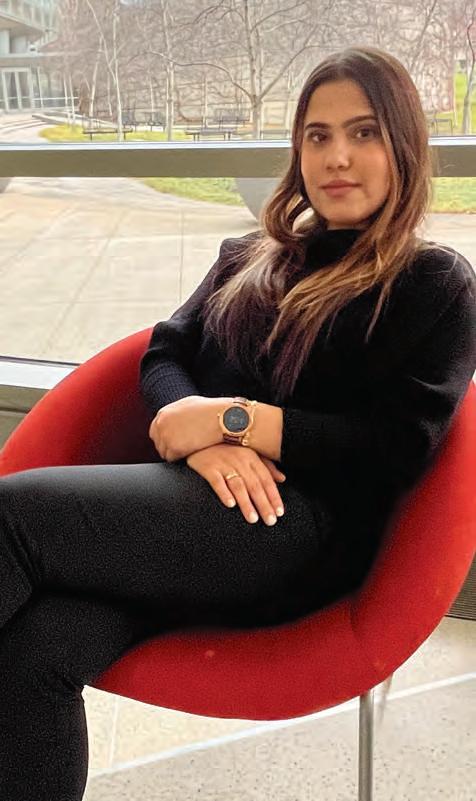



Caudell





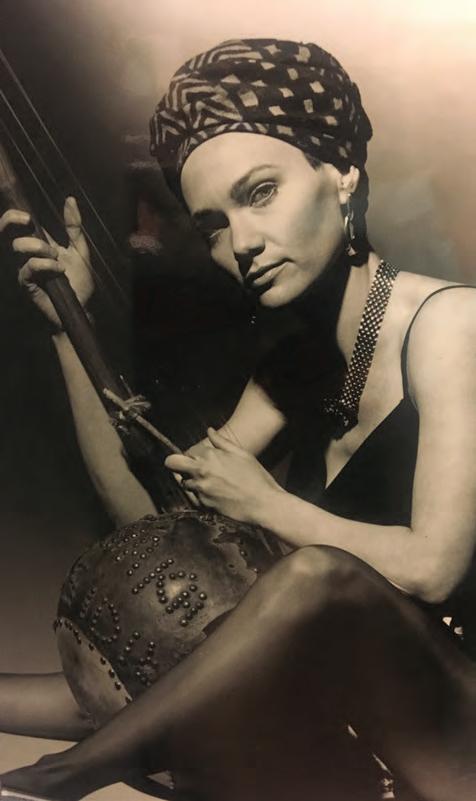


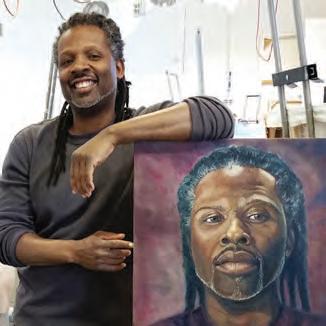





PHOTO PROVIDED BY SABRINA JARRAH
The words that best describe me are: Passionate, creative, and learner. Whether it’s my work at the AAHC or organizing in my community, I have found that my passion not only brings more meaning to my work but also sustains it. is passion has also allowed me to bring forward creative solutions to the challenges that arise within our organization and with my work on the ground. In every role I take on, I have learned that when we tap into our community’s expertise, talent and ideas, we can bring forward meaningful change that will allow us to build a transformative and sustainable future together. My passion, creativity and commitment to lifelong learning have better positioned me in my work as an organizer and my future as executive director.
What is your favorite family recipe?
A dish called warak enab (stu ed grape leaves) – always a go-to choice for big, family dinners at my house. Traditionally, grape leaves are stu ed with rice and meat (or veggies) and placed in a pot alongside pieces of lamb and potatoes to cook for about an hour. e process requires a lot of patience, as it is one of the more time-intensive dishes. Growing up, I loved watching my mom and grandma talk about life and share stories as they stu ed and rolled warak enab together. is recipe has
become one of my favorite dishes to make with my mom, and it is now something that I regularly make for friends and family.
What’s one thing that can instantly make your day better?
I’m so grateful to be surrounded by mentors, colleagues and friends who inspire me every day. Knowing that I have such an incredible community around me has gotten me through my hardest challenges. ey have given me hope during tough times and played important roles in my organizing.
What’s your favorite way to spend a day o ?
Quality time with family and friends is something I value tremendously. is year, my work and school schedules have made it di cult to nd time for myself. However, in the last few months, I have tried to create more opportunities during the week to call or spend time with friends and family. We all need these spaces in our lives to strengthen our connections to each other and where we can rest, re ect and grow together.
Do you have any hobbies?
I have always loved watching, studying and discussing movies. Movies played a signi cant role in my life growing up, and I fell in love with the way stories can be













“My passion, creativity and commitment to lifelong learning have better positioned me in my work as an organizer and my future role as executive director.”


captured and shared through the medium. As I got older, I realized that what I loved most about cinema was the ability to celebrate art, share space and build community with those around me. is fascination with cinema eventually inspired me to create a student organization that would highlight the power of the arts and the intersection between art and activism.
My mom (Bahia Mourad) is a big hero of mine. She is the reason I am who I am today. Her incredible love and sacrice have given me the strength to stretch the boundaries of what is possible in my life. A trailblazer in her own right, she has fought hard in her life and always encouraged my siblings and me to be compassionate, tenacious and resilient. She truly holds our family together. I’m so blessed to have her support to carry me through every challenge and success in my life.

What’s one work-related thing you want to accomplish in the next year?














A primary goal of the AAHC is to build Arab American political power by making our voices heard through civic engagement and ensuring our communities are represented. Currently, Arab Americans are signi cantly undercounted in the census and other federal data, which has had dramatic consequences on Arab American representation. As a result, organizations like AAHC struggle to secure funding for resources and services that our community needs. is challenge will continue to impact our work in signi cant ways, and that’s why it’s something I’m fully committed to ghting for in my capacity as executive director. ®























BY CHERYL DENNISON


January is National Slavery and Human Trafficking Prevention Month. Every year since 2010, the President has dedicated the month to raising awareness of the different types of human trafficking – also known as modern slavery –and educating people about this crime and how to spot it. January 11 is Human Trafficking Awareness Day. Here is what is being done to raise awareness and to eliminate human trafficking that is happening right here in Genesee County.
May of 2018, G.H.O.S.T. (Genesee Human Oppression Strike Team) was initiated by Genesee County Sheri Christopher Swanson (when he was undersheri ) with authority granted by then-Sheri Robert Pickell. Swanson had been involved with a West Coast international organization that supports enforcement of human tra cking laws and the rescue of sex tra cking victims through the use of special forces. A year prior, he took a trip to Haiti where he worked with an intel-gathering group. Some women from Europe had been promised employment at a ve-star resort in the Dominican Republic and instead, their passports were taken from them, they were put on a bus and shipped to Haiti where they were tra cked for sex 24 hours-a-day.

During that mission, Swanson worked with a group of undercover operators with law enforcement and military experience, who posed as “customers.” e tra ckers brought the victims to the customers, the victims were rescued and the tra ckers were then arrested by the national police.
After that successful operation, Swanson thought to himself, “If this is happening here, and it is the fastest growing criminal enterprise, I have to believe it’s also
happening in Genesee County.” This led to the formation of the G.H.O.S.T. task force within the Genesee County Sheriff’s Office, whose purpose is to apprehend human traffickers and people who attempt to have a sexual relationship with a child.

According to Swanson, the first rescue in Genesee County happened in May 2018 without additional funding or additional people. “We added this to our normal duties,” he explained. Potential victims were identified through contacts with Probate Court, DHHS, and by using a list of kids who were age 17 and had no known address or location. “These kids are the members of the population who are most vulnerable to trafficking,” Swanson states. There were 72 names on the list. “We found and identified 50 of the kids on that list.”

Not all of those kids had been tra cked, the sheri explained; but their nal stop was a house o Fenton Road that led to the discovery of a 15-year-old girl who had been locked up, living in a bathtub and covered in bruises and cuts, who was being pimped out. “ at was the real deal.” Swanson said. “ at was the wakeup call for my team.”








Since thatfirst rescue in 2018, over 149 predators have been arrested. Swanson has also taken G.H.O.S.T. members to 35 Michigan counties so that other sheriffs could learn how to form their own strike teams. And, according to the sheriff, human trafficking is mobile. “It moves from town to town,” he says. In Michigan, any person under the age of 17 who is involved in commercial sex is, by definition, a victim of human trafficking.
Education, awareness and aftercare are important aspects of human trafficking, the sheriff states. The sheriff’s office uses partners in Genesee County including Voices For Children and Whaley Children’s Center for promoting education and awareness. “We have several aftercare partners that help victims who have been rescued get the physical, emotional, spiritual and psychological rehabilitation they need.”
Of the trafficking cases that have been prosecuted, Swanson is happy to report an impressive conviction rate. “That is because of the expertise and professionalism of G.H.O.S.T. and the team members who work to make it happen – who put cases together in cooperation with the prosecutor who has been battle-tested,” he says.
The G.H.O.S.T. team has caught the eye of Emmy Awardwinning filmmaker, Nick Nanton, who filmed a documentary about human trafficking titled, “It’s Happening Right Here.”
The G.H.O.S.T. members and Swanson are both in the opening scene. The documentary is set to be released in 2022.

“I believe it’s going to be the number one human trafficking documentary of the year!” Swanson exclaims.
As January is National Human Trafficking Awareness Month, Swanson says part of their messaging is to get the community, experts, moms and dads, grandmas and grandpas, churches, teachers and friends all involved in helping the fight against human trafficking. “Clearly, they can’t be involved in the law enforcement aspect, but they can be part of the team,” he adds. The task force has started a program that parallels the G.H.O.S.T. team called the G.H.O.S.T. Certified Program, which will be launched at the G.H.O.S.T. open house event taking place from 4-6pm on January 26. Attendees will have the opportunity to meet G.H.O.S.T. team members and also to be recognized as a Certified G.H.O.S.T. member.

Anyone who wants to become a Certified G.H.O.S.T. member can complete an online tutorial which includes a short examination. Those who pass the exam are allowed to provide a safe place for someone to go who needs help or has questions about human trafficking. Once a person or organization is certified, they will receive a signed certificate and a large sticker (to be used for identification) from Sheriff Swanson.

Swanson reiterates the fact that human trafficking is the fastest growing criminal enterprise in the world. With just one victim, a trafficker can gross $200,000-$250,000 per year, he reports. “It’s a huge business,” he states. “Together, we can fight it. This is my personal call to action.” ®



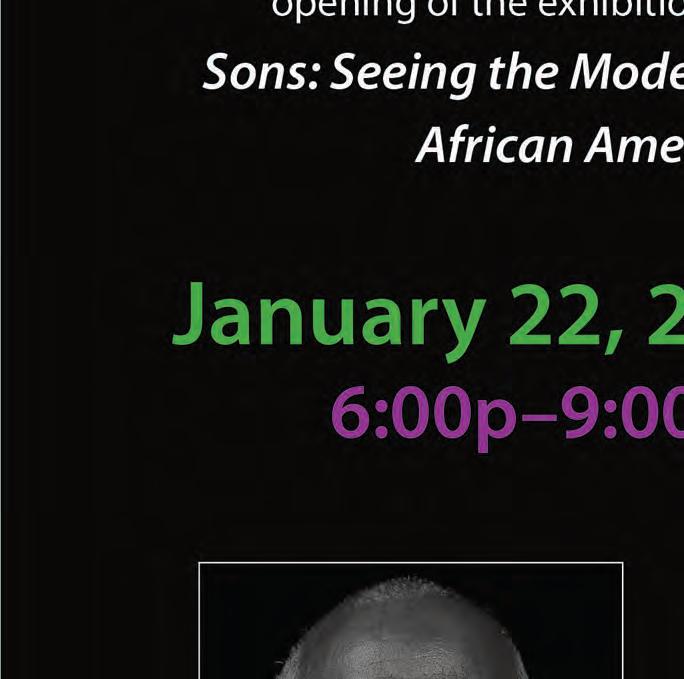









BY CHERYL DENNISON ® PHOTOS PROVIDED
BY SCOTT
SASSACK
InNovember 2021, the Flint & Genesee Group announced the winners of the Art of Achievement Awards at a ceremony held at e Capitol eatre in Downtown Flint attended by more than 450 people. Winners of these prestigious awards are selected from nominations gathered throughout the year. Last year, 16 awards were presented to businesses, hospitality professionals and community
leaders for their signi cant contributions to the region’s success in 2021.
Great Harvest Bread Co., founded in 2003, was the recipient of the Small Business Award. Scott Sassack, who coowns the business with his father, Bob, attended the ceremony along with his wife, daughters and two of the managers of the company. “I had no idea we would win!” Sassack exclaimed. “I was shocked.” When accepting the award,

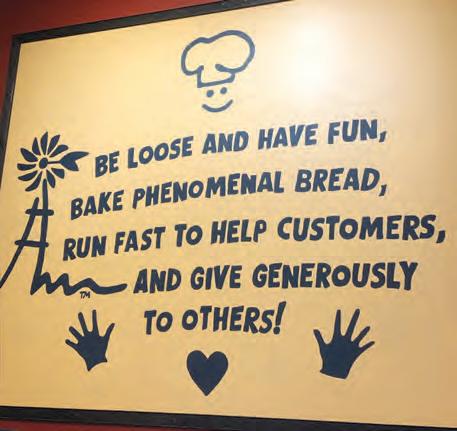
he invited his family and sta to join him on the stage. “It was a team e ort – I’m nothing without my team.”
According to Sassack, the Small Business Award is given to a business in Genesee County that has less than

“I don’t look at Great Harvest as just a business. I love my employees, I love my customers and I love what I do.”
Scott Sassack, Co-owner
50 employees that has made a signi cant contribution to the area. Part of the Great Harvest mission is “to give back generously to others.” “ at’s very important to me,” says Sassack. “It’s not just a business, it’s about being part of the community.”
During the pandemic, there was a very high demand for products the bread company o ered. With only eight employees, they worked diligently to meet the need.
In a three-to-four-month time frame, Great Harvest stores also supplied nurses, doctors and hospital ICU workers with 500-1,500 sandwiches. “Police, re ghters and EMTs could come to us for a free sandwich,” Sassack stated. e company also supplied loaves of freshbaked bread to organizations including
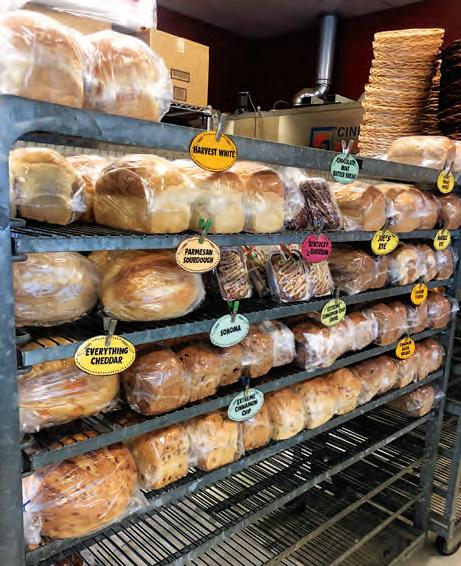
the North End Soup Kitchen, Salvation Army, My Brother’s Keeper and various churches. “What the Chamber saw in us, I believe, was that we were going above and beyond what was expected.”
Great Harvest has two locations –in Grand Blanc and in Flint at Flint Farmers’ Market. “We are a scratch bakery,” the owner explains, adding that it takes ve hours to make a loaf of bread from start to nish. Bakers arrive at 3am to start the process. “We mill
our own wheat every day.” e menu includes fresh-baked cinnamon rolls, scones and mu ns, as well as a variety of sandwiches, salads and soups. “We make everything from scratch that day.”
At the height of the COVID-19 pandemic, Great Harvest Bread Co. saw a whole new group of customers who were looking for products that were not available in grocery stores, and they became regulars. And it’s customer service that is a priority for Sassack. “Customer service is my forte. I don’t look at Great Harvest as just a business. I love my employees, I love my customers and I love what I do.” ®





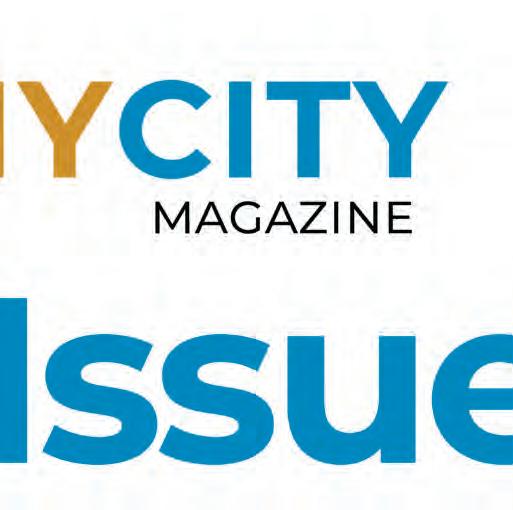
















Last year, COVID-19 threw a wrench into the Back to the Bricks© Annual Chrome & Ice™ Winter Indoor Car Show which was to be held at Flint’s Dort Financial Center. So, we are going BIGGER and BETTER in 2022! anks to Title Sponsor General Motors and our Brought-to-You-by Sponsor Dort Financial Credit Union with special thanks to ABC-12, we have ALL NEW surprises planned for this threeday indoor classic car event.
e 7th Annual Chrome & Ice™ Winter Indoor Car Show will take place February 11-13. One exciting feature is an amazing collection of iconic movie cars in the lobby – cars you will recognize from historic lms like “Batman,” “ e Dukes of Hazzard,” “Smokey and the Bandit” and many more! PLUS, we will exhibit classic and custom vehicles, motorcycles, sports cars, muscle cars, hot rods and trucks in the two arenas and on the mezzanine. With more than 50 sponsors and automotiverelated vendor displays, demonstrations, concessions, live entertainment and a chance to attend our VIP Experience on Friday night, we know it will be a good time!
Chrome & Ice™ 2022 will be open to the public on Friday, February 11 from 2pm-8pm, Saturday, February 12 9am-9pm, and on Sunday, February 13 from 11am-4pm. On Sunday at 3pm, commemorative clocks valued at $250 will be awarded to the Top 25 vehicles.
Car Show General Admission tickets are $10 for adults and $7 for youth ages 12-17. Children under 12 are admitted free. Arena parking is $5 at the gates.
Brought back by popular demand is the VIP EXPERIENCE on Friday night from 6-8pm. Tickets are $40 each and will include car show general admission and live musical entertainment with the John Vance Band and Country Recording Artist, Josh Gracin. PLUS, your VIP Experience Ticket includes a complimentary adult beverage at any of several bars in the arena, gourmet hors d’oeuvres and dessert on the walkway above the Green Arena from 6-8pm, compliments of Dort Financial Credit Union. Proceeds from Chrome & Ice™ and the VIP Experience will support the Back to the Bricks® Youth Scholarship Fund.









On Friday night, Dort Financial Credit Union will present the rst-ever Chrome & Ice™ Member Appreciation Concert. e John Vance Band will kick o the show before country music recording artist, Michigan native and former Marine, Josh Gracin takes the stage. VIP ticket-holders will have reserved concert seating. Friday event tickets are $25 for the car show and concert, or $15 for the concert only. Come out, see the movie and TV cars, and rock out to the chart-topping sounds of “Nothin’ to Lose,” “Stay with Me (Brass Bed)” and “We Weren’t Crazy.” Chrome & Ice™ is an excellent way to ESCAPE THE WINTER BLAHS at a fun, safe and family-friendly event! ®











Genesee County’s oldest Catholic Church permanently closed in December 2020. It was the only Catholic parish in the city of Flint for 67 years. “It was such a signi cant church,” said Father Tom Firestone. e church had struggled nancially for some time and the number of parishioners had dwindled. e building was turned over to Catholic Charities, who had hopes of making the necessary repairs. “We don’t want to lose it,” said Father Firestone. “It is still a Catholic church. My main concern is that the side chapel remains open. It’s been the light of the community. We are not going to leave this city.”
My City Magazine
COMPILED BY CHERYL DENNISON
Ayear after the start of the COVID-19 Pandemic, the Greater Flint Area has been on the rebound. During that time, MCM found many interesting stories to share. Here is a look at some of last year’s most memorable.

Flint’s Future is Female: Building a
is group was co-founded by Rachel Johnson and Heidi McAra with the goal of connecting women with resources and support to help them succeed with their business and professional aspirations. e mission is to promote connectivity and
empowerment to female leaders, founders and entrepreneurs. “One of our goals is to encourage a new generation of females to get involved in their community and its organizations,” Johnson stated. “As Flint’s rebirth continues, women leaders and entrepreneurs have a chance to make a big impact on the city’s future.”

Living the Dream is article pro les the long and exciting hockey career of former Grand Blanc resident, Jon Merrill. Chosen to be the ag-bearer for a Detroit Red Wings game at age 13, he played three years for the University of Michigan (helping them to the 2011 national championship game while earning all-conference honors), represented Team USA in international competition,
and won back-to-back World Under-18 Championship gold medals before taking bronze at the World Junior Championships. His NHL career included four seasons with the New Jersey Devils before joining the newly-formed Vegas Golden Knights and playing in a Stanley Cup nal. In October 2020, his ultimate childhood dream came true when he signed with the Red Wings.

In recognition of Black History Month, MCM honored 21 of the many African American leaders and trailblazers (past and present) who have worked
for the betterment of the city and its people. ose honored and pro led included notables from the elds of government, education and medicine; the clergy, arts and culture; the legal community and law enforcement, rst responders and sports standouts.

In October 2020, Breanna Nicole Trecha of Fenton Township obtained the rank of Female Eagle Scout –the rst female in Genesee County and one of ten in the State of Michigan – following in the footsteps of her father and three brothers who were also Eagle Scouts. “It is an honor, but it takes a lot of time and determination to accomplish it,” Trecha said. “It is achievable if you work hard for it.”
February cont.
In November 2020, Flint Native Bob Campbell published his rst novel, Motown Man, a story of an interracial romance set in a faded, Midwestern industrial town. Campbell said, “Much of the setting is in an automotive components plant. I was able to explore gender role, family relationships, interracial communication and factory life. Humanity of the Black man is a signi cant theme.” Born and raised in Vehicle City, Campbell attended Southwestern High School, worked for GM for seven years and was a writer for various newspapers, including the Flint Journal, Lexington Herald-Leader and Detroit Free Press. Campbell is currently the senior communications manager for the Flint & Genesee Group.
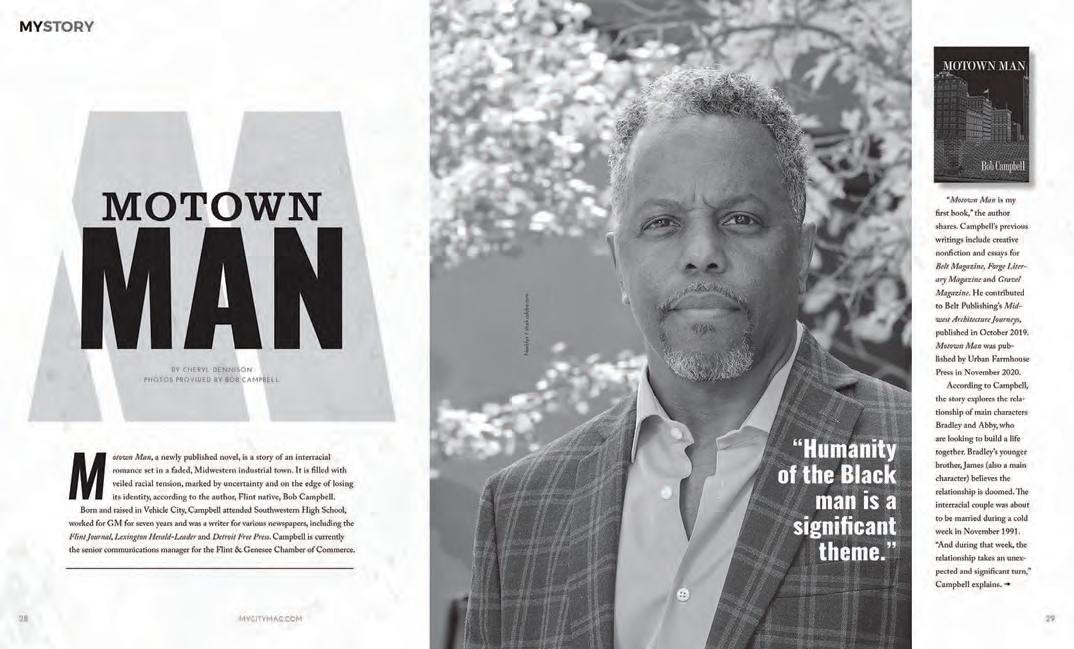

Planning for the new 61,000-square-foot wing began in 2015, and opened with a ribbon-cutting ceremony in January. e project was aided by a $29.25 million capital outlay appropriation from the State of Michigan, and the Charles Stewart Mott Foundation awarded an $11 million grant to help fund construction, upgrade the existing building and support STEM studies campus-wide. e wing features robotics labs, design lab and fabrication workshops, independent and group research labs, reservable group-study rooms, student club hub and learning commons, to name a few.

Chief Christopher Miller
Bishop Airport Police Chief, Christopher Miller, announced his retirement and was ready to relax and enjoy life after spending the last 20 years working tirelessly as the airport’s Chief of Public Safety. “I worked professionally non-stop for almost 39 years,” he said. Miller received a call from Mayor Sheldon Neeley who told him he was one of ve people who would receive the City of Flint Lifetime Achievement Award and a key to the city. “He told me that it was the highest award a citizen can be given and I am deeply honored to receive it,” Miller said.
After a hard-fought game played at Ford Field to decide the 2021 Division 7 State Championship, the New Lothrop Hornets bested perennial championship contender, the Traverse City St.
Francis Gladiators. “ at last drive was the best of the year for us,” said Coach Clint Galvas. “It iced the game.” e win was celebrated with a dance party in the locker room with Galvas a willing participant. When the team’s bus rolled back into New Lothrop, the players received a hero’s welcome.


April is National Garden Month and MCM’s annual Home & Garden Special Section o ers tips for creating your dream garden, current decorating trends and more!

Basketball and Flint go hand-in-hand and its reputation for the game is legendary.
“Basketball is a sport synonymous with Flint and we want to continue the tradition," said Kevin Mays, Team Market Owner of the Flint United Basketball franchise. Flint and sports have always
been a big part of Mays’ life. He was a standout athlete at Carman-Ainsworth, an athlete at Central Michigan University, spent time as the director of sales for the Flint Firebirds and worked with the National Champion Flint City Bucks. He loves the city and has always wanted to contribute to its growth. “A professional team in Flint just made perfect sense,” Mays added.
At age ve, Marks was a regular on stage at Flint’s Church of God in Christ, belting out beloved gospel songs. “I would close my eyes when singing in church because I would look out and see people crying,” she says. “I didn’t quite understand it at the time, but later realized they were only happy tears and that God was using my voice to reach them.” Marks’ passion for using her singing talent to entertain, touch hearts and soothe souls was born. She spent the next 25 years honing her gift. In March 2021, she released Our Country, her rst album in 14 years.
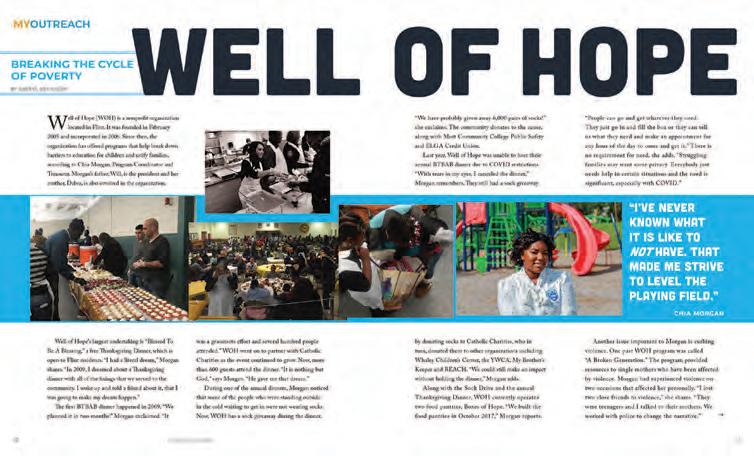
is Flint nonpro t was founded in February 2005 and incorporated in 2006. Since then, the organization has o ered programs that help break down barriers to education for children and unify families. e group is run by the Morgan family: Chia Morgan is Program Coordinator and Treasurer; her father Will is the president and
her mother Debra is also involved in the organization. Well of Hope’s largest undertaking is “Blessed To Be A Blessing,” a free anksgiving Dinner open to all Flint residents. “I had a literal dream,” Chia Morgan shares. “In 2009, I dreamed about a anksgiving dinner with all of the xings that we served to the community. I woke up and told a friend about it, that I was going to make my dream happen.” And, she did!

Rebecca’s Reason
Founded in 2016 by Sarah Curtis, the mission of this nonpro t organization is to provide nancial assistance to families who have lost a child or their child has been diagnosed with a life-limiting illness. e organization was named to honor the brief life of Curtis’ daughter, Rebecca Anne. Her baby was born with Edward’s Syndrome and died in her mother’s arms 12 hours after her birth. To deal with the grief, Curtis began searching for a way to give meaning to Rebecca’s life. “I decided I could raise money to help other bereaved parents pay their medical bills,” she said. “If I could o er that tiny light in their darkness, Rebecca’s life had reason.”


“It was the most impressive accomplishment I’ve seen in my wrestling history.”
Davison Cardinals Are State Wrestling Champs
It was a year unlike any other! A 2021 win over Detroit Catholic Central in the state nals gave Davison their ninth MHSAA State Wrestling title and their rst in 15 years. As an added bonus, Davison was able to end rival Detroit Catholic Central’s streak of four consecutive titles. “It was a little poetic justice,” says Coach Zac Hall. “We set that second-place trophy right in front of the training room door so the kids couldn’t miss it. It helped heat up the rivalry.” Davison nished with ve state champions and a record-breaking 14 wrestlers selected as all-state athletes. “It was the most impressive accomplishment I’ve seen in my wrestling history,” says Hall.
After votes poured in from everywhere – over 18,000 of them – Greater Flint chose their favorites in nearly 200 categories! e layout featured art created by Flint Public Art Project artists.

ings have changed at the Genesee County Jail since I.G.N.I.T.E. (Inmate Growth Naturally and Intentionally rough Education) launched in September 2020, the vision of Genesee County Sheri , Christopher R. Swanson.
e education, re-entry and rehabilitation initiative was designed to eliminate generational incarceration through education by restoring value, hope and purpose to the inmate population. “We don’t call it a program,” says Capt. Jason Gould, Jail Administrator. “It is a cultural change, a way of thinking.”

After experiencing a plethora of success as a head coach at the college, club and high school levels and as assistant in the semipro and pro ranks, Andy Wagsta became the Flint City Bucks head
coach in 2020. Shortly after that, however, the COVID pandemic put defense of the Bucks’ championship on hold. ey did play six exhibition matches last fall in an empty Atwood Stadium, winning all of them by a dominating 26-2 margin. e team has never experienced a losing season.
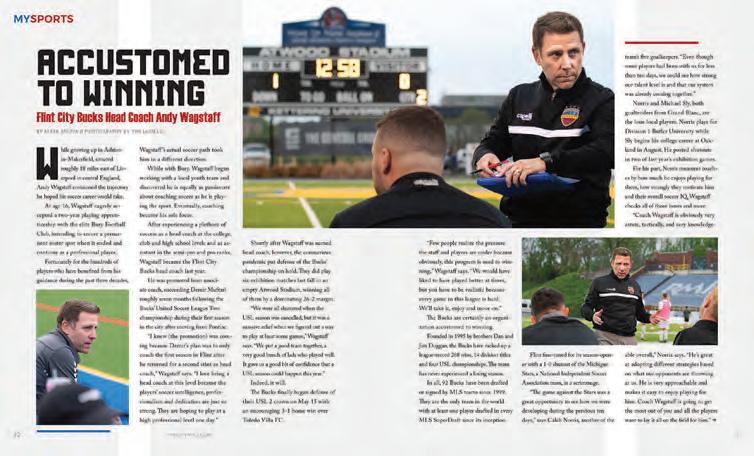
A project of the Flint River Watershed Coalition (FRWC), this nonpro t group was created to protect, promote and improve the Flint River and its watershed. Since September 2018, the approximately 3.25-mile public paddle trip has launched behind Tenacity Brewing and ends at Mitson Riverview Landing. e project o ers nature enthusiasts an opportunity to view the city from a di erent perspective while enjoying a peaceful trip down the Flint River, according to Sarah Scheitler who co-manages the project with Jaime Welch. “It is a beautiful resource that not enough people know about,” says Scheitler.

As soon as classes began in 1928, Flint Northern High School was a powerhouse in both academics and sports, winning its rst two state championships just two years later in football (behind bruising fullback, James McCrary) and in tennis. Soon thereafter, the mascot was changed to the Vikings and the rst of many basketball championships was won under legendary Coach, Jim Barclay. MCM Assistant Editor Peter Hinterman shares the history of the school and some of its academic and sports highlights.

More Marvelous Murals!
In 2019, Flint Public Art Project (FPAP) started phase one of their plan to paint 100 new murals in Greater Flint by the end of summer 2020. e project was successful beyond imagination, exceeding the goal and bringing Flint positive news coverage and notoriety. At this printing, more than 150 murals had been completed throughout the Flint area. FPAP also partnered with Kady Yellow and the What’s Up Downtown Project to o er mural tours, and with the Flint Repertory eatre to present “Flint Mural Plays” written by some of the country’s best playwrights.


“We are going to surprise people with what we do this season and put the Fury back on the map.”
The GREAT Reset: Flint Fury Football
“We are going to surprise people with what we do this season and put the Fury back on the map,’’ said Charles Lawler, Owner/Head Coach. Lawler labeled the 2021 season “ e Great Reset,” changing the team’s colors from navy, silver and white to red, black and white. And, the Fury’s promising start for the season made all of Lawler’s e orts feel worthwhile. e team, 4-4 in 2020, took a 2-1 record into their June 19 game against Tri-City Stampede. “ e season has been great so far because we’ve improved with every game, which is a really good sign,” Lawler said.


e month of August brought many exciting festivals and thousands of visitors to Downtown Flint including the Crim Festival of Races, Back to the Bricks, live shows at the Capitol eatre,
cultural events and an abundance of eateries! Attendees of these world-class events had plenty of other things to enjoy Downtown – unique shops to browse, a happening new hotel, inspiring mural art and much more!
Frame 42: The New Generation of Rock Rock is not dead! When Frame 42 took the stage in June 2021 for their EP release party at Diesel Lounge in Detroit, the capacity crowd wasn’t ready for the assault. Boasting dual female lead vocalists, perfect guitar harmonies and foundational bass and drum play, the band possesses the sound, talent and energetic fervor of all the greatest bands of the 70s, but packages it into something uniquely their own.

School’s Back! What’s New for Flint Students
For an overview of the 2021-22 academic year, MCM reached out to our local colleges: Kettering University is now positioning itself and its students to be key players in the fast-paced world of mobility for its next century. Mott Community College is ready to help students prepare for a changing world with a supportive learning environment and degree and certi cate programs. And, Michigan State University Extension’s Family Enrichment Series (FES) was created with the goal of helping families live happier lives.
“Flint shaped all I know. I’ve lived in other cities and you can’t run away from it – it’s in you, not on you.”

Rylie Dewley Miss Michigan’s Outstanding Teen
Using a multitude of photographs, igpen designs each piece of art exactly how he sees it inside himself. His unique style, evolved throughout the course of his life, portrays the African-American experience from a August cont.
She’s a standout! In June 2021, the Grand Blanc teen was selected Miss Michigan’s Outstanding Teen. e creator of Start Heart Smart (spreading awareness of heart disease) and a talented baton twirler, Rylie has dreamed of being crowned Miss America since she was a little girl. And she is well on her way to making that dream a reality. Competing since the age of ten, she has won pageants including Miss Sunset Coast Outstanding Teen, Miss Lake Erie Outstanding Teen and Miss Washtenaw County Outstanding Teen.

universal perspective. And each work holds a little bit of himself and his home city. “Every piece is a collage constructed from multiple images and each one re ects a little of home,” he says. “Flint shaped all I know. I’ve lived in other cities and you can’t run away from it – it’s in you, not on you.”

september
In this special section, “We Remember,” MCM shared the story of Eric Bennett, the only person from the Flint area to perish in the 9/11 attacks. Also featured were personal accounts of the experience working to rescue and recover victims at Ground Zero from former re ghters, Joe Ludwig and Steve omson. Advertisers sponsored highlights of area re and law enforcement personnel to honor the brave rst responders who answer the call every day. Community members shared their memories about a day we won’t – and cannot – forget.
Soon
she was

MCM talked with Flint’s rst poet laureate, named in September 2019 by then-mayor Karen Weaver. Brown is a poet, educator, playwright, author, performer and thought leader who received the 2021 Academy of American Poets Poet Laureate Fellowship Award, which was given to 23 poet laureates across the country. e recipients received $50,000 to help them grow public poetry programs in their communities. “It is really an honor,” Brown says of the award. e monetary gift will be used to continue her civic focus, the Poetry Pod.

cont.
Located in the newly renovated and revitalized former Woodside Church building directly adjacent to the Mott Community College campus, the LCFLC provides a variety of student services needed to improve success. After an $8 million renovation,
the building features a large concert hall, multiple study/general areas, an expanded child care facility, a food pantry and Ellen’s Closet where students can get free career clothing for interviews. e LCFLC provides assistance with child care, housing and transportation and emergencynancial assistance, among many other services.
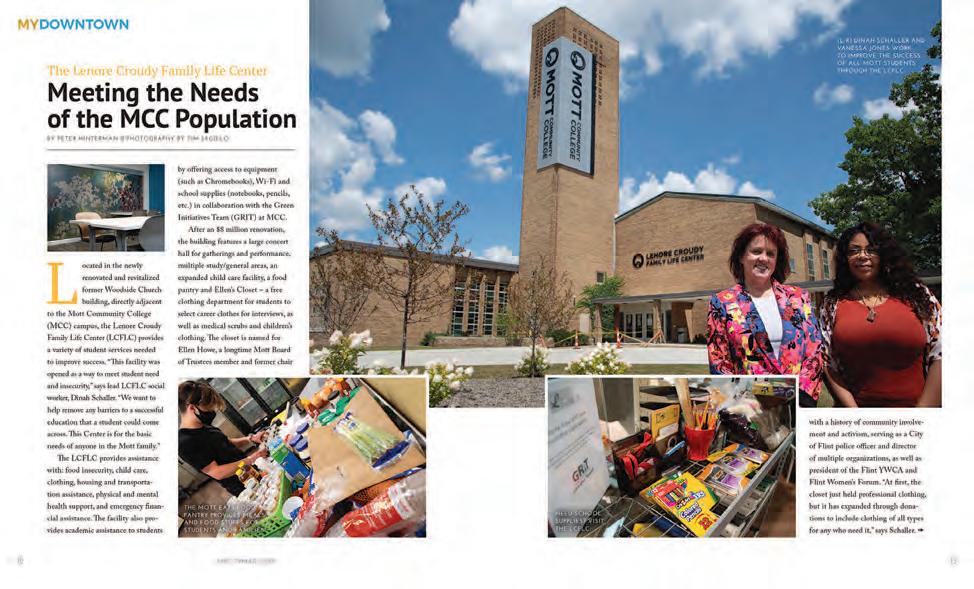
“Half Dead Fred” A Flint Horror Story

Flint has its dark legends, tales of haunted buildings and scary stories; but never has the horror come to life on the big screen – until now! Filmed in Flint, the new movie “Half-Dead Fred” promises chills, mystery and a new image for the city as a place separate from un attering media attention. “Flint is tired of being portrayed negatively and deserves to be regarded as a positive place,” said writer/director Bron eron. “We are lming a horror movie, but we will show the murals, businesses and locations in a positive light.” Production wrapped at the end of September and eron hoped for an early 2022 release.
MCM shined the spotlight on Amy Ley, Principal Harpist for the Flint Symphony Orchestra and Windsor Symphony Orchestra. e talented musician has held the principal harp position in the Lansing Symphony, Ann Arbor Symphony, and Saginaw Bay
Orchestras. Ley has performed with the Grand Rapids Symphony, National Ballet Orchestra in Toronto, Kitchner-Waterloo Symphony, Orchestra London, Toledo Symphony, and Charleston Symphony. She also performs as a part of the Walla Walla Chamber Music Festival in Washington and the Lancaster Music Festival, OH.


In 2014, eSports (competitive video gaming) went collegiate when Robert Morris University - Illinois organized the rst varsity team. Today, colleges across the nation have elded varsity teams, with Michigan being one of the states leading the way. is article highlighted Genesee County’s three very competitive programs: Kettering University, Mott Community College and UM-Flint.

7 Questions with … Kara Ross
e President/CEO of Food Bank of Eastern Michigan graciously answered “7 Questions” for this up-close and personal feature. When asked what she enjoyed most about her career, Ross said, “I enjoy the focus on community and mission. e FBEM partners with an incredible network of organizations, volunteers, our team and caring community members. It’s rewarding to see how people working together can make an incredible di erence in the lives of so many.”

Started in 1985 under the City of Flint’s Aging and Handicapped O ce and in collaboration with the national AmeriCorps VISTA (Volunteers in Service to America) Program, the Vista Center has helped thousands of people over the years gain a sense of freedom, respect and help in their everyday lives. For many developmentally
disabled, homeless or mentally ill adults, the Vista Center in Flint is a source of community and compassion. “We provide a place where they can come to get out of the house and escape loneliness and isolation,” explains Director Pat Beal,” and we will continue to add programs that bolster their quality of life whether through art, dance or other creative outlets.”

As Shane Prouix watched the 2008 Summer Olympics, the Grand Blanc man became enthralled with the dizzying, frantic pace of team handball. He was fascinated by the way it incorporated elements of several sports he had thrown himself into at various times in his life – like basketball, soccer, hockey and rugby. He wanted to nd a way to play it. So, in fall 2020, Proulx and wife Mylisha founded Flint City Handball Club and barely a year later, it became an o cial USA Team Handball club. “We’ve found a passionate group of players who do everything they can to promote the club. It’s been pretty remarkable,” said Proulx.

“I love seeing what can be accomplished when people work together, giving of their hearts and their time.”
is is the third year
My City has recognized a citizen who is an advocate for the Greater Flint community and dedicated to making it a better place through volunteerism and service. And 2021 was a very special year for our deserving honoree, as Church will retire in February after 45 years with ELGA. Church talked
with MCM about her love for her community, her years with the credit union, her service in the City of Flint and plans for the future. “I’m a little bit sad,” she admits. “ELGA Credit Union has been my life for 45 years.” Community service has always been very important to her. “I love seeing what can be accomplished when people work together, giving of their hearts and their time,” Church said.
Founded over three decades ago, TDN has been advocating for the disabled community in Greater Flint and around the country. e organization was started by Mike Zelley, father of TDN CEO Luke Zelley, after he attended a meeting of the Genesee County Handicapped Alliance in 1992. Of the 60 people in the room, only two (including himself) identi ed as disabled. He thought that the disabled community should have more robust representation in the county. Since that time, TDN helps an average of 10,000 people each year through local programming and another 100,000 throughout the nation via government policy changes for which they fought and advocated.


Desert Angels, Inc. is volunteer faith ministry was founded by Louise Downs Blain, of Linden, and has been sending a “Miracle Box” to military service personnel for the last 20 years. Blain said she attended the funeral for a young Michigan soldier named PFC Joseph (Joe) A. Miracle, who gave his life for his country on July 5, 2007. “On my way home from the funeral, God put it on my heart to name our boxes ‘Miracle Boxes’ after Joe,” she said. Among the many snacks, treats and personal care items, each box contains a photo of Joe, a bit of information about his life and service, a note of encouraging words, a prayer cloth and a U.S. ag. ®
The Valley Area Agency on Aging (VAAA) is the go-to resource for any and all things senior-related. Incorporated in 1976 to serve the senior population of Genesee, Shiawassee and Lapeer counties, the VAAA has been the area leader in senior information and programming for nearly 50 years. With a mission to provide answers, action and advocacy on care for the elderly and disabled adults in an e ort to sustain their independence and provide support to caregivers, the VAAA helps approximately 10,000 people per year through numerous programs and services. “One of our main goals is to keep seniors in their homes and keep them independent for as long as possible,” says President and CEO, Yaushica Aubert.
e VAAA provides services for individuals 60 years old and older, disabled individuals 18 years or older, and their immediate caregivers. “We help anyone with any questions concerning seniors and the disabled, be it legal help, senior center locations, vaccinations, Medicare navigation, transportation, bill-paying or anything else,” informs Aubert. If you are a caregiver who may be feeling “burned out” and need help or relief, the VAAA awaits your call. “We can provide options for caregivers to get the help they need. Give us a call – we are all things senior,” adds Aubert, “and the majority of our services are free of charge.”
VAAA provides assistance with a range of services including assisted living placement, care management, home-delivered meals, legal services, home-to-home transitions, home adaptation and modi cation, medical equipment training and utilization, personal care (grooming, dressing, housekeeping, etc.), transportation and support groups. e organization provides education in the areas of elder abuse prevention, caregiver training, cooking, art therapy, nutrition and exercise. If you are feeling lonely, the VAAA provides social opportunities such as the CHAAT (Chatting Helps Aging Adults

rive) program, RSVP (Retired and Senior Volunteer Program), health and exercise programs, and special events.
“When someone calls the VAAA, we will ask a lot of questions in order to get all of the information we need to make sure we get you into the correct program or service,” says Aubert. “Next, we may send a nurse or social worker to your home to determine your exact needs and quali cations. Your coordinator will then arrange your service and continue to make sure your needs are met.” e VAAA will always be there for anyone who needs assistance.
If you have questions of any sort concerning yourself or a senior family member, call VAAA and someone will be happy to assist you. For more information or an in-depth description of what VAAA can o er you or your family, visit valleyareaaging.org.
VAAA is federally funded but in need of monetary donations (100% of donations goes directly to programs) to help alleviate waiting lists, and needs volunteers to support their programming. If you are interested in volunteering, please call 810.239.7671 and talk to a representative. To donate, visit valleyareaaging.org and click on the “Donate Now” button. ®
The staff at Valley Area Agency on Aging are the experts in senior independence and advocacy. Call 810.239.7671 for all things senior.


BY ERIN CAUDELL
With each New Year, I start looking for great new recipes that are tasty and nutritious. Of course, we typically gravitate toward meals that are warm and comforting, but I always feel that adding more fresh greens to my diet helps perk me up from the winter blues. And consuming the extra vitamins this time of year is always a good idea.
My new food obsession is quick-pickled onions. I make a super-simple pickling mixture (warm two parts vinegar and one part water in a saucepan over low heat, until it steams). en, I put several thinly sliced, large red onions in a bowl and pour the pickling liquid over them. I put them in the fridge to cool overnight, and they’re ready! e onions add a lovely tartness to a winter salad recipe, like this yummy roasted beet salad with great avors, textures and nutrition.
INGREDIENTS
• 5 oz spring mix, washed
• 2 large or 4 small beets
• 2 oz feta cheese, crumbled
• 2 oz pomegranate seeds, cleaned
• 2 oz sun ower seeds, toasted
• 2 Tbsp olive oil
INGREDIENTS
• 4 Tbsp olive oil
• 2 Tbsp balsamic vinegar
• 1 clove of garlic
• 1-2 Tbsp honey
• ¼ tsp black pepper
• ¼ tsp salt
For the dressing, peel and mince garlic and add to all other ingredients in a small container with a tight lid. Shake until the honey has dissolved completely. Set aside.
Peel the beets, toss with olive oil, wrap in aluminum foil and roast at 375°F for 30-40 minutes. Let them cool completely.
To the spring mix, add beets, feta, pomegranate seeds, sun ower seeds, pickled red onions (or raw, thinly sliced onion). Drizzle with the LemonHoney Dressing. ®

Erin Caudell is co-owner of The Local Grocer, a horticulturalist, herbalist and farmer.











BY PETER HINTERMAN PHOTOS PROVIDED BY MARTIN TURNER

Atsix years of age, Martin Turner made the discovery of a lifetime.
“My kindergarten teacher had given me a box of clay to play with because she saw my interest in sculpting di erent things,” he remembers. “Of course, I was a kid, so that clay didn’t last very long. I left the last piece outside one day and the next morning, it was gone. I was heartbroken and my parents told me that since I had wasted what I had, they weren’t going to get me any more.”





Soon thereafter, Turner was watching a TV program with his family when they saw an advertisement for aluminum foil. “I remember the commercial saying that aluminum foil could be molded into di erent shapes,” he says. “I immediately got some from the kitchen and sure enough, it molded just ne. My rst sculpture was an airplane.”


From then on, Turner was using aluminum foil and his imagination to sculpt and create unique pieces of art for friends and family members and today, that discovery many years ago has led to a ful lling profession of art and creativity. He runs a successful art studio in which he completes commissioned works in a variety of forms including drawing, painting and, of course, sculpting, as well as lling the role of art program coordinator for Sylvester Broome Empowerment Village (SBEV).
His talent was evident early on, but Turner did his best to keep it hidden. “When I was young, I didn’t believe that anyone could make a career of art,”


he says. “Growing up in Flint, I was stuck in the belief that the goal was a factory job or manual labor. I wish I had thought di erently. Better late than never, I guess.” At Flint Northern High School, his creativity became public and he soon found himself making small sculptures for other students. “Mostly dogs and other pets,” he says. en, while in the military, he was asked by his peers to create small sculptures of bald eagles, wolves, dogs and other items with patriotic themes. Even then, Turner never truly realized the potential of his talent. After his military service, Turner fell in line and got a factory job. It wasn’t until 2006, when he had a serious accident, that he decided to embrace art full-time. “I was hurt and could no longer work in a factory,” he explains. “It was a blessing in disguise. I took my art seriously and enrolled in classes at Mott Community College. As I learned to expand my talent and to think on a grand scale, I improved immensely.”










Turner’s sculpting process is distinct in that it has been developed by him alone – a singular technique built through years of experience. e majority of his works are composed of aluminum foil (no clay or any other shaping medium is used) and he uses drywall putty to ll in gaps and help with painting and nishing. From concept to completion, the process can take anywhere from a single day to weeks. “My nishing techniques are constantly evolving,” he shares. “My artistic life is full of ‘happy accidents,’ as Bob Ross would say.” As far as inspiration goes, Turner sees it everywhere and is always surprised by what he creates. “I can see the shape of my next sculpture in the leaves of a tree or lean of a building, and when I start working, I often lose time and nd that it’s already past midnight or early the next day,” he laughs.
When not in his studio, Turner spends time at SBEV coordinating the art program and working with young artists in a variety of mediums. “We recently started sculpting and the class just nished making a large
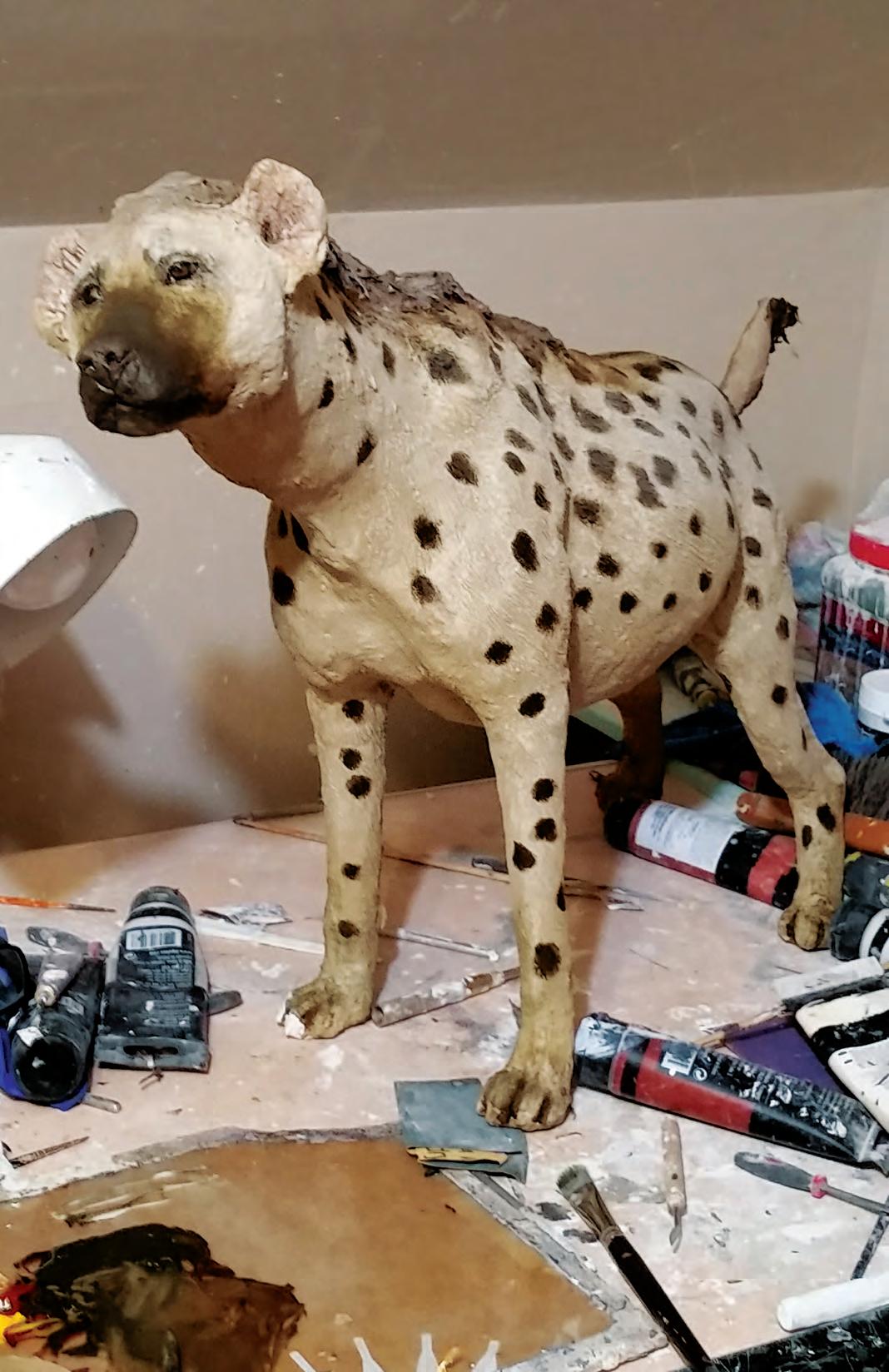




hippopotamus that they painted pink with green spots,” he laughs. His goal at SBEV is to grow the children’s talent and awareness of art, and to help them understand the importance of art and how it can truly become a lifetime profession. “I want them all to understand that art doesn’t have to just be a hobby,”

he explains. “It can be pursued as a living. You can get paid to do something you love. At SBEV, we try to help kids think like entrepreneurs. I want them to avoid the rut that I fell into for so long.”
For years, Turner has been silently sculpting and creating and now, his hard work and talent are getting noticed.



SCULPTURES FOR THE URBAN SAFARI PROJECT COMING THIS SUMMER
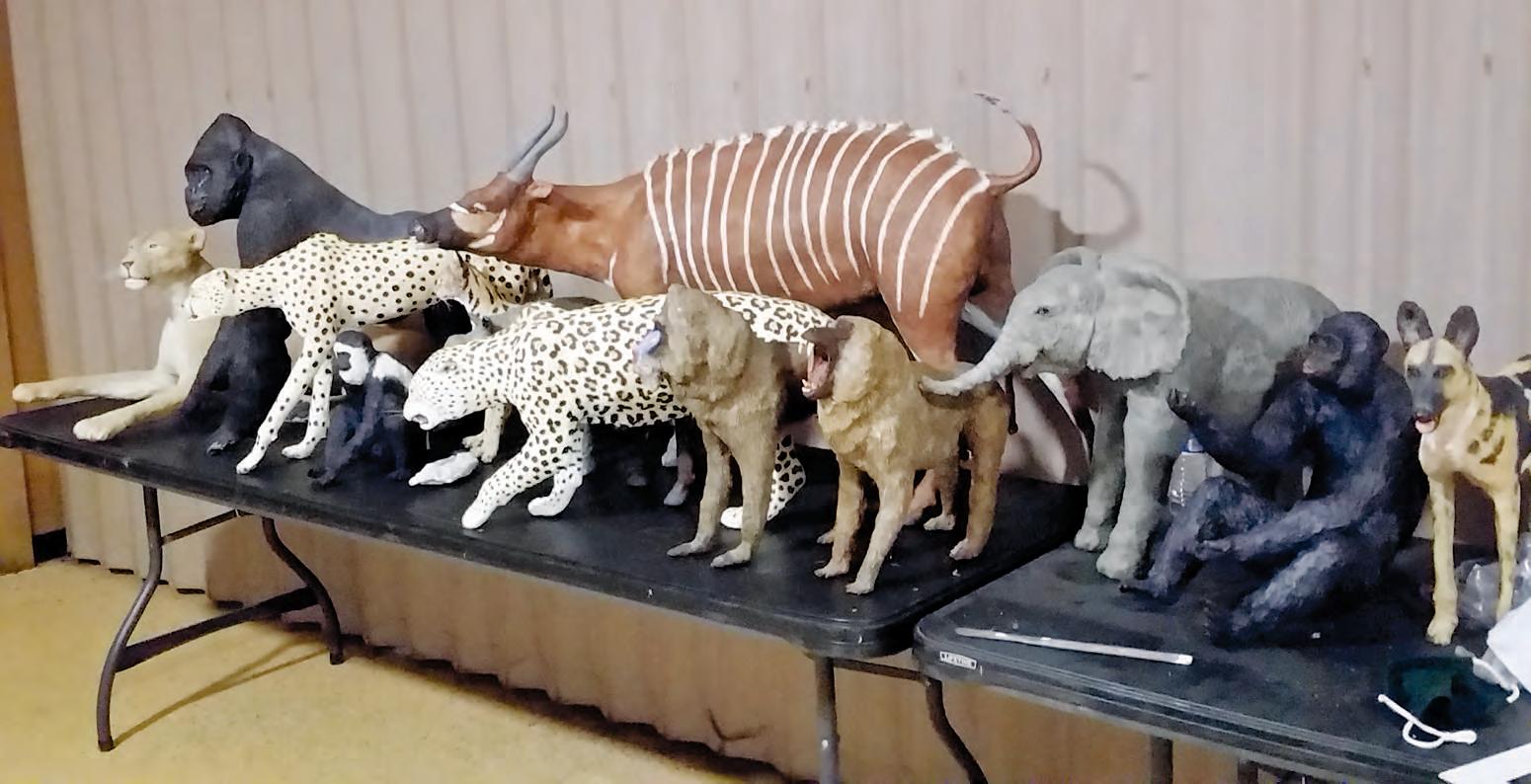


"When I was young, I didn't believe that anyone could make a career of art."
Martin Turner
In 2020, he was chosen as winner of the GFAC All Media Membership Exhibition Competition and currently, he is working with the Urban Renaissance Center sculpting all of the animals for their North End Safari Project scheduled to launch next summer. “I’ve nished 21 of the 30 sculptures for the project,” he says. e animals include a gira e, rhino, hippo, water bu alo, leopard and many more. He is also diligently working through a backlog of client commissions and recently began



adding personal and celebrity busts to his catalog of sculpture subjects.
Turner hopes to continue to play a role in Flint’s resurgence well into the future and sees art as something that can set Flint apart. “Again, a main goal of mine is to help spread the love and importance of art through the kids and people of the North End,” he says. “Like basketball, art can be a boon to this city.”


If you are interested in the art of Martin Turner or wish to commission a piece, visit his Facebook page or @mautymaud on Instagram.
Turner is also looking to acquire multiple desktop easels for his students enrolled in the art program at SBEV with the goal of teaching them vertical drawing and painting. If you would like to help, email martin@sbev.org. ®

BY PETER HINTERMAN ® PHOTOS PROVIDED BY HEATHER MAXWELL
rom her rst enthusiastic “hello” to her closing “stay beautiful and stay safe,”
Heather Maxwell’s love for African music and culture lls each and every episode of “Music Time in Africa” as well as every day of her life. “I love the rhythm of African music and how it is used and appreciated in the community,” she says. “For Africans, music is a very communal thing.
ere, people view music as a natural extension of being human.”
Broadcasting across the entire African continent, “Music Time in Africa” is the longest running English program produced by Voice of America (VOA), the United States’ largest international broadcaster. Started in 1965, the program broadcasts traditional and contemporary African music throughout the continent, spanning all genres and styles.
And, since 2012, the voice of the program has belonged to Maxwell, Flint native and ethnomusicologist.
“‘Music Time in Africa’ is a specialty music program that broadcasts in English to approximately 17 million listeners across Africa,” she explains.
“In 1965, when the program started, Africa had no established radio programs or stations and many believed that it was important for the country to have music by Africans.


MAXWELL MET WITH LOCALS IN ZIMBABWE AS AN AMBASSADOR FOR VOA.


e program continues today as a form of cultural diplomacy and a show of respect between our country and the peoples of Africa.” Maxwell acts as show host and disc jockey, bringing news of new artist album releases, playing past and present African hits, and interviewing current artists. She has traveled extensively throughout Africa, meeting its people, promoting the message of the U.S. and VOA, and collaborating with professional musicians. In Africa, her persona and likability are akin to the late Casey Kasem of “American Top 40”. “I’ve heard that comparison before,” Maxwell laughs.
Music has always been a large part of Maxwell’s life. It began when she was a child living on the outskirts of Flint, singing with her family’s gospel band, e Maxwells. “We used to sing throughout the state and even

MAXWELL WITH A UNIVERSITY OF GHANA REPRESENTATIVE
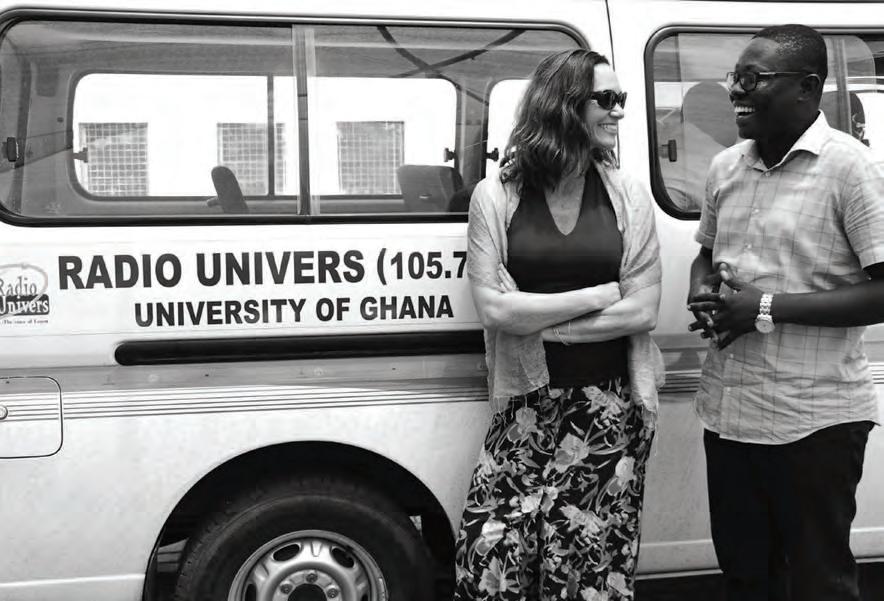
performed on the Jerry Lewis Telethon,” she remembers. She studied opera at Interlochen Arts Academy and after graduation, continued her voice training at the University of Michigan. It was there that her fascination with African music began after taking a variety of world music courses.
“I left Michigan in my junior year to attend the University of Ghana in Africa to study music and dance,” she recalls. “I was fascinated.” After graduating, she joined the Peace Corps and was placed in Mali where she learned to speak French and Bambara, the local language.

LEFT: MAXWELL WITH BAND TIHAREA FROM MADAGASCAR. BELOW: COLLABORATING WITH A MOROCCAN PERFORMER

From there, it was back to Michigan for post-graduate work focused on African music. Maxwell took a job teaching at the University of Virginia and applied for others; but Africa continued to beckon.





“To this day, I get pangs of nostalgia for living in that little village in Mali,” she adds. “Sometimes, I wish I could wake up in that little hut, feel the sun, smell the smells and be in that space. I miss the musical moments when we would play instruments and sing under the moonlight. It’s there that I learned to play two common African instruments – the kamalen n’goni and balafon.”
“I was teaching French but felt in my heart that it wasn’t what I truly wanted to do,” she says. “I applied for a Fulbright scholarship to teach in Mali and was accepted.” It was then that the VOA job opened. “I heard through a friend that the host for ‘Music Time in Africa’ was retiring.



"I love the rhythm of African music and how it is used and appreciated in the community.”

For those curious to hear the different styles of African music, Maxwell has compiled a list of some of her favorite songs and artists.
1. “Je Vais te Marier” by Neba Solo

I drove directly to Washington, D.C. I wanted the job so badly. ey told me the process would take time and I had the one-year Fulbright commitment in Mali. I was there for about six months when a political coup took place. I was hastened out of the country and given the job at VOA.”
It was a perfect t and Maxwell has been a hit ever since. And soon, she will begin traveling to Africa again after travel stopped in 2019 due to the pandemic. “ ere are plans to visit Algeria in January for a North African musicians festival, and again to the Ivory Coast in mid-March for a large music conference.” Each location provides a plethora of di erent musical styles, beats and sounds. “One of the great things about African music is the range of styles,” she explains. “ e continent is three times the size of the U.S. and there is no real way to categorize a common sound.
In West Africa, they use a lot of percussion; in North Africa and desert areas, the ute is most common and in South Africa it’s choral in nature. You can’t describe it in just one way.”
For Maxwell, hosting “Music Time in Africa” is a dream come true. “I never thought I would be doing this and I’m so glad that I am,” she says. “I have devoted much of my life to African music and I believe that ‘Music Time in Africa’ has a positive e ect on and touches many Africans. African music touches the heart.”
“Music Time in Africa” is broadcasted every weekend in Africa with streams available in the U.S. at voanews.com. For videos and more, visit “Music Time in Africa” on YouTube and Facebook.
When not broadcasting or traveling, Maxwell is actively making music of her own with a unique fusion of African music and jazz. Find a sample at heathermaxwellmusic.com. ®
This is an example of balafon music from Mali on which I based my master’s thesis. It is an example of West African polyrhythm and syncopation.
2. “Ewe 6/8 Rhythms” by The Pan African Orchestra
Another example of West African polyrhythm and syncopation, specifically, the kind of 6/8 rhythms from Ghana that captivated me in college.
3. “Soke Wo (Dance Party)” by Dogo du Togo
An example of current-day, Ewe traditional music by a Washington, D.C.-based Togolese singer.
4. “Wimoweh” by Manu Dibango featuring Ladysmith Black Mambazo
This is an example of Southern African choral beauty. Ladysmith Black Mambazo is a well-known vocal group from South Africa with whom Paul Simon recorded his 1986-album “Graceland.”
5. “Andou Zine” by Asma Lmnawar
This is one of my all-time favorite North African (Morocco) singers and my favorite song by this artist.














BY MARK SPEZIA ® PHOTOS BY TIM JAGIELO
They may be few in number, but their energy levels, enthusiasm and dedication are seemingly limitless. is is the conclusion just about anyone setting foot in a Mott Community College wrestling team practice is likely to draw.
Under the direction of a youthful rstyear head coach – 25-year-old Aaron Ward – seven wrestlers begin most practices with intense drills before going head-to-head
on mats helping each other perfect moves, polish their skills and build stamina.
Assisting Ward is former MCC head coach Winston Ru n, who guided the program’s transition from club status to an o cial National Junior College Athletic Association team. at process was completed prior to the start of last season, which was Ward’s rst as an assistant coach.
Still, Ru n felt Ward was ready to switch roles with him.
“I love wrestling and love giving back to the sport, so the opportunity to become a head coach has been a blessing,” Ward says. “It has been di erent, though. I’m not much older than the wrestlers which helps as far as getting down on the mat and practicing with them, but now I am the one doing most of the yelling. In the end, I just want to make sure they are doing things right and truly be there for them.”
Ward indeed loves the challenge he has taken on.
e Bears began the season only being able to ll six of ten weight classes and all six wrestlers are in their rst year. e lone returnee, NJCAA National Tournament quali er Brody Kemper, became eligible to compete in late December.
Still, in a classic illustration of quality over quantity, that has not stopped Mott from being ranked 22nd in the nation, just four spots below where the Bears were ranked at the conclusion of last season.
Despite giving up points by forfeiting weight classes, Mott beat Ancilla College in a dual match by a point and lost to St. Clair County Community College by just six points.
“So far, so good – considering our lineup is all true freshmen,” Ward says. “It’s great to be ranked, but I’ve told the

guys it’s not about winning this season. It’s most important to get used to competing at the college level, which is an entirely di erent ballgame. At the same time, I feel we are capable of being ranked in the top ten by the end of the year based on how far the guys have come.”
Grand Blanc graduate William Miller has already worked his way into the national NJCAA rankings, sitting ninth at 125 pounds with a 6-4 record prior to the Bears’ December 18 match against Rochester College. He nished in the Hawks Invitational in Dearborn.
“It’s a great atmosphere, because we all connected with each other right from the rst week of practice,” Miller says. “We are also all between 125-157 pounds which means we all have solid practice partners and are not working with the same person every day. at has really helped us all develop.”
e squad has become close-knit away from the mats, as well.
“Just the bus rides to competitions and staying at hotels have been good bonding times for us, along with hanging out together outside of practice,” says Miller.


Everyone in MCC’s camaraderie- lled wrestling room has a unique story of how they wound up there.
Ward and Ru n actually o ered Miller a scholarship to wrestle at Mott after his senior season, but he told them he planned to enroll in a trade school and that his competitive wrestling days were over following a high school career during which he placed fourth in the Division 1 state tournament as a senior.
Miller also quali ed for the state tourney as a junior and nished with a 113-59 record.
Kemper, Miller’s former high school teammate, ultimately convinced him otherwise.
“When my trade school plan didn’t pan out, I thought I would just take classes at Mott, but Brody said the wrestling team could probably use me and that I should come to a few practices,” he says. “I was impressed and when the coaches told me a scholarship was still possible, that was it.”
Rodney Richards experienced what Mott’s program is like while still in high school.
He wrestled at Kearsley High School under coach Darnell Ru n, Winston’s cousin. Every ursday during the season, Richards, another teammate and his coach attended Mott’s practice and joined in.
“It was a pretty fun experience and I loved how much work everybody was getting in,” Richards says. “ ey were grinding all day, going at each other nonstop. After practice, they were like family, sitting around, joking with each other, just chilling and hanging. I had to be part of that.”
Richards joined the Bears after qualifying for the Division 2 state tournament



twice during high school, including placing fth in the state as a senior. He nished with a 112-36 high school record and is o to a 7-3 college start.
“It’s going pretty good, but I know I need to do more running outside of practice to build my stamina,” says Richards, who weighs less than 150 pounds, but has wrestled as high as the 165-pound weight class to help ll out the MCC lineup. “ e guys are certainly more skilled in college. You’re always going to face a quality opponent.”
As for Ward, he began laying the foundation for a coaching career while wrestling under two of the top high school coaches in state history. He started at Stevensville Lakeshore under the tutelage of Bruce Bittenbender, Michigan’s all-time winningest coach with 958 victories heading into this season.
Ward then transferred to Lowell for his senior year, helping the Red Arrows to their second straight Division 2
team state title and rst under rstyear coach R.J. Boudro, who has won six more in a row since.
Individually, Ward nished sixth in the state at 125 pounds and continued his career at NCAA Division 3 Adrian College.
“I was very fortunate to learn so much about coaching the right way from coaches like Bruce and R.J.,”
Ward says. “At Mott, I apply things I picked up from them because they both know what works as far as running a quality program.”
After less than two seasons at Adrian, Ward returned to his native Dowagiac on the state’s southwest side and landed his rst coaching gig as an assistant on the high school sta for the 2017-18 season.
Ward helped Dowagiac to its rst team state quarter nal berth in 14 years. At the same time, he began feeling he was not done wrestling competitively.
During that season, Ward also found out he and girlfriend Autumn Chapman,


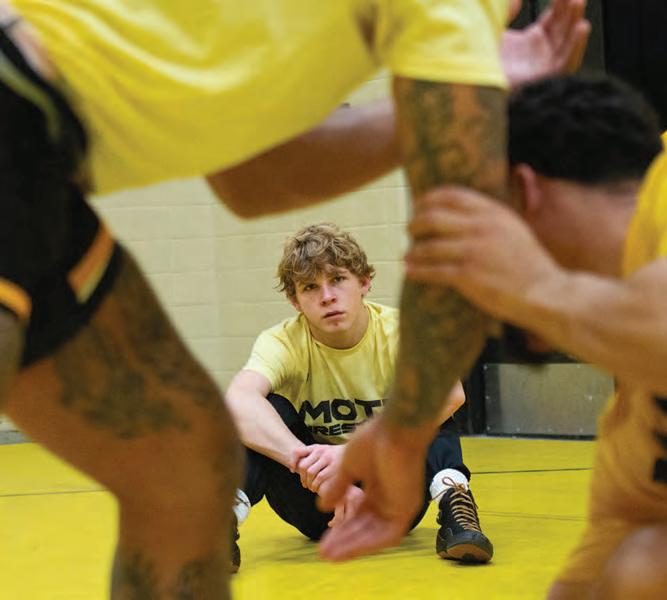
a Flint native who wrestled for Kearsley, were expecting a daughter. at, coupled with a desire to resume wrestling, brought Ward to Mott in the fall of 2018.
As a club team, Mott was a member of the National Collegiate Wrestling Association and Ward nished eighth at NCWA National Championships that season, becoming an All-American. He also won a conference title and
quali ed for the national championships again the next season.
Winston Ru n, a 1998 state champion and four-time state medalist for Montrose High School, then asked Ward to remain with the program as his assistant. He helped Ru n guide the Bears to third in
ASST. COACH



LakeVille graduate Nate Young (141 pounds) was second at the Hawks Invitational. e two-time state qualier was seventh in the Division 3 state tournament as a senior and nished with a 147-32 record.
Others on the roster are Durand graduate Gabe Fielder (141/149), North Branch’s Gavin Cotterman (133) and Miguel Gutierrez (157),
“I love wrestling and love giving back to the sport, so the opportunity to become a head coach has been a blessing.” Aaron Ward
the Michigan Community College Athletic Association tournament and 22nd of 35 teams in the NJCAA National Championships last season.
Kemper, who went 3-2 in the tourney, was one of ve national quali ers.
A three-time state medalist with more than 150 career wins, Kemper was also third in the MCCAA tournament. He wrestled unattached in the Ben McMullen Open in November and placed third at 149 pounds.
who wrestled for Dundee-Crown High School in Carpentersville, IL. Fielder, a Division 3 state quali er, nished with a 103-43 high school mark.
“We should be better next season with all weight classes being lled and our returning guys helping mentor the rst-year guys,” says Ward, now a father of two. “If we train like we can and peak at the right time, I truly believe we have three or four potential All-Americans and can make the top ten in the national tournament.” ®











BY PETER HINTERMAN
After the establishment of the Michigan School for the Deaf, the building of St. Michael’s Catholic Church, and 44 years after Jacob Smith built his trading post at the Grand Traverse of the Flint River, the growing village of Flint became a city. After reaching a population of 2,000 in 1855, Flint was quickly becoming a center of commerce and industry in Michigan. Soon after being incorporated as a city, the rst municipal elections were held on April 2, 1855 in the city’s three early wards. e next day, Grant Decker became the rst Mayor of Flint. is series will chronicle each of Flint’s mayor’s throughout history, providing a short account of their professions, lives and decisions made in o ce (if known). Some were men/women of great deeds, some of great controversy. Some simply acted as placeholders in time. Each of them, however, chaired a city important to its country and citizens on its path through triumph and heartbreak, and toward its revitalization.

e city’s rst mayor, Decker arrived in 1838 from the state of New York. He began work in the lumber industry, built a our mill with Artemas ayer and owned interests in a our and feed mill with Ira H. Wilder. One of the founders of St. Paul’s Episcopal Church, Decker served in the vestry for more than 40 years and played the ute as one of the church’s rst musicians. In 1837, he married Elizabeth Stevens who died in 1844 of consumption (tuberculosis). e next year, he married the sister of William M. Fenton, Julia Isabella Fenton. In all, Decker

1856-57
Mayor No. 2 was attorney Robert J. S. Page. He came to Flint in 1838 and was appointed receiver in the Genesee District of the U.S. Land O ce. In 1850, he was elected to serve in the o ce of Justice of the Peace and would later serve on the bench as a probate judge. Page was also one of the county’s foremost “wildcat bankers,” establishing the Flint River Bank and serving as president, cashier and sole proprietor. Page died in 1875 and was buried in Glenwood Cemetery.
had six children – ve daughters and a son. His son was taken prisoner at Gettysburg during the Civil War and died in Andersonville Prison. Decker died in 1890 and was buried in Glenwood Cemetery, which he co-founded. At St. Paul’s Episcopal Church, a stained-glass window near the main west doors was dedicated in memory of Grant and Julia Isabella Decker by their daughter, Julia. Decker Street in Flint is named for the former mayor. During his year in o ce, the wagon business began in the city.
Henderson came to Genesee County in 1836 and opened a dry goods store with his brother, James. In 1848, as a commissioner of the Genesee County Plank Road Company, Henderson received the authority to construct a plank road from Flint to Grand Blanc on the Saginaw Road. Two years later, Henderson and Company were appointed commissioners of the Genesee & Oakland Railroad Company and tasked with building a railroad connecting Flint and Pontiac. In 1855, the railroad was extended to Saginaw County. In 1859, the Flint & Pere Marquette Company purchased the rights, property and franchises of Henderson and Company’s railroad. In 1865, Henderson became president and director of the newly formed First National Bank. He acted as vice president of the Glenwood Cemetery Association and therefore, played a large role in its establishment. He died in 1879 and was buried at Glenwood. During his time as mayor, the Randall Carriage Factory, Flint’s rst vehicle factory, was established.


A man who needs no introduction around these parts, Fenton was elected Flint’s fourth mayor in 1858. e namesake of the City of Fenton, he came to Genesee County in 1837 with his friend and business partner, Robert Leroy. ey settled in what was known at the time as Dibbleville. As Fenton and Leroy platted the area, they decided on an o cial name for the settlement by way of a naming-stakes poker game. Fenton won the rst hand and dubbed the newly-platted land as Fentonville. In 1846, Fenton was elected to the state senate where he was instrumental in securing the Michigan School for the Deaf in Flint. Twice, he was elected lieutenant governor
1860-61
Serving as Mayor of Flint until the outbreak of the Civil War, Crapo spent his life as a businessman and politician on both local and state levels. He came to Flint in 1858 and established the largest individually owned lumber rms in the state. He played a large role in the construction of the FlintHolly Railroad and was its president until its purchase by Flint-Pere Marquette. In 1862, Crapo was elected to the state senate and elected governor for two consecutive terms starting in 1864. While governor, the 13th Amendment abolishing slavery was sanctioned and Radical Reconstruction was endorsed. In Flint, Crapo purchased 1,000 acres of swampland
and was appointed by President Pierce as register of the land o ce in Flint. At the outbreak of the Civil War, he was commissioned colonel of the 8th Michigan Infantry under the command of General Sherman. Colonel Fenton rose to fame by winning battles at Port Royal and Secessionville. His regiment took part in the battles of Bull Run, Campbell Station, Wilderness, Spottsylvania Court House and others. Upon his return to Genesee County, he was named chief engineer of the Flint Fire Department. In 1871, he perished after sustaining an accident while on duty. Colonel Fenton was buried in Glenwood Cemetery. During his time as mayor, Flint’s rst telegraph communication system was established, with the inaugural message sent from Flint to Fenton.
* ere is dispute as to whether Fenton served two mayoral terms; some records indicate Porter Hazelton having served from 1859-60.

near Swartz Creek. He had the swamp drained and there he established the famous Crapo Farm. His daughter, Rebecca, married William Clark Durant and their son, Billy Durant went on to found General Motors. During the end of his last term as governor, Crapo became sick and nally succumbed in 1869 at the age of 65. He was buried in Glenwood Cemetery. Crapo Street in Flint is named in his honor.

A Jack of all trades, Williams had traveled plenty and engaged in multiple professions before landing in Flint in 1850. He traveled with his family to Detroit after escaping the advance of the British during the War of 1812. After growing up in Pontiac with his family, Williams and his brother travelled to Saginaw under employment with the American Fur Company. ere, he built the rst sawmill in the Saginaw Valley. During his years in Saginaw, Williams was elected county clerk and register of deeds, and was appointed postmaster by President Jackson. In 1840, he relocated to Pontiac where he started a mercantile business and tried his hand at farming. In 1850, he settled in Flint and engaged in the grocery and crockery business. He was appointed postmaster of Flint by President Pierce and spent eight years in the position. Williams perished in 1890 at the age of 88 and was buried in Oak Hill Cemetery in Pontiac. Ephraim S. Williams chronicled many of his journeys and adventures as a pioneer in Michigan and his stories can be read in various editions of the Michigan Pioneer & Historical Society Collections.

Here, there seems to be a bit of historical confusion in the records, with some marking William Patterson as mayor during this year and others citing William Paterson (spelled with one “t”). It seems they are di erent people and not much is known about either. What is known is that William Patterson was on the building committee to construct the city courthouse ( nished in 1851) and it is his last name (with two “t”s) on the list of Flint mayors in the Historical Collections and Researches text issued by the Michigan Pioneer and Historical Society. e other William Paterson is generally thought of as the o cial mayor and his career does provide correlating evidence of this – most notably, he was elected supervisor of Flint Township multiple years starting in 1845. After his possible mayorship, he opened one of Flint’s rst non-wildcat banks with capital provided by George and Porter Hazelton. Before the bank o cially opened its doors, however, Paterson disappeared with the funds, never to be seen again. (Note: is is not William A. Paterson, the American Automobile maker.) During this time as mayor, the Flint & Pere Marquette Railroad was established and Smith-Bridgman’s Department Store opened for business.

One of Greater Flint’s most prominent farmers and lumber merchants, Hamilton lived in the area for most of his life and acquired several hundred acres of farmland, including that upon which the Buick City Complex was built. He was elected to two consecutive mayoral terms and served a third from 1876-77. Hamilton Ave. in Flint was named in his honor. Hamilton died in 1899 at the age of 75 and was buried in Calvary Cemetery. During his rst two mayoral terms, the rst City Hall building was built, the Flint & Holly Railroad started and Flint’s rst theater, Fenton Hall, was opened.

Porter Hazelton traveled with his brothers from New York to Genesee County where, under contract with the State of Michigan, they built a bridge across the Flint River. In payment, the Hazeltons received land in Shiawassee County that would become Hazelton Township. Instead of settling, the brothers sold the land to early settlers and pioneers. Hazelton was elected Flint Township supervisor in 1852. Porter and his brother George, along with James Seymour of Flushing, commissioned an extension of the northern road through Genesee County into Lapeer County. Porter Hazelton died in 1870 at the age of 56 and was buried in Glenwood Cemetery.
*See entry for William M. Fenton ®










BY VERA HOGAN
The month of January is the one time of year when we all get a “clean slate” to start over, or at least make some positive changes in our lives. Like many people, I have never been too successful at making and keeping New Year’s Resolutions, with “keeping” being the operative word. Typically, the top spot on our list of resolutions is occupied by “getting healthier” – changing our eating habits and exercising more. Also high on the list is ridding ourselves of bad habits like smoking, alcohol consumption and other behaviors that can hold us back from living happier, healthier and more productive lives. People also vow to be kinder, help others more and volunteer when possible – we can all do these things. rough my later years, I have struggled with my weight, and until last year, exercise was not high on my list. Now, to keep from having to walk on all fours due to chronic back issues, daily exercise is a must for me. But even though I feel better, I don’t like to do it.
As for eating more healthfully, there is one thing I will never ever give up: chocolate. I’ve given up enough things in my life and I refuse to let chocolate be one of them! It can be the nest Swiss chocolates from Europe or an inexpensive box of chocolate-covered cherries. If there’s chocolate, I’m in. is leads me to my new resolution for 2022 … trying ethnic foods I’m not too familiar with. I have always loved Italian, German and Asian dishes, but I’m not too familiar with French or ai cuisine, for example. I have tried and do enjoy Middle Eastern food, but I’m sure there are many more I would enjoy. is year, I’m going to experiment with as many as possible.
I have at least two good friends who can literally live on Mexican food. I have never been a fan but having said that, my experience with Mexican fare has been limited to tacos

and a few other basics, like burritos and enchiladas. I’m sure there is more to like and I need to give it another chance.
In 2020, there were more than 65,000 Mexican eateries in the United States. As of 2019, it was an over $62 billion industry in this country! Yes, I think I will give Mexican food another chance. Not taking a political position on this one way or another, that’s pretty amazing when you consider the wall that was started at the Mexican border. My late husband and I used to laugh and say, “You can’t come in – but before you go, can you drop your family recipes in the big wooden box?”
On January 1, 1892, Ellis Island in the New York Harbor welcomed the rst of what would be 20 million new arrivals from other countries until it closed in 1954. Unless you’re a Native American, you’re likely a descendant of immigrants and have eaten meals all your life that originated in a foreign land. And that includes what we consider all-American foods like apple pie, hot dogs and hamburgers. ®
Happy New Year! Let’s eat!
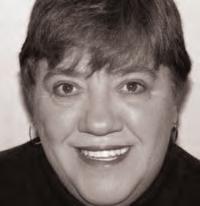
Recently retired, Vera Hogan is a 20year veteran of the newspaper business, having served both Fenton and Flint area publications. During those years, she was a reporter, associate editor, editor, web content editor and columnist. Her popular columns have earned her multiple state awards. She resides in the City of Fenton. Email verahogan@hotmail.com.



BY LESLIE TOLDO


Asmuch as I wanted to buck tradition and skip making resolutions for 2022, I have o cially made one.
Yes, I guess that does mean I have already broken my original resolution to not make resolutions, because resolutions are usually broken by February, anyway.
For the New Year, my big life goal is to be more loving – to everyone, even challenging people – especially challenging people.
I have always been a hugger. Ever notice huggers like to announce that they are, in fact, huggers? In my case, it has never been about pride, but more a way of warning people in the immediate vicinity that a hug could be forthcoming. It has always worked well, because people who do not want or like to be touched will (often very dramatically) let a hugger know that it better not happen.
Some huggers are hurt by the rejection; I have always appreciated someone letting me know they are not comfortable with hugging. It’s about respecting boundaries.


e truth is, there are many people I have not wanted to hug.
I do not wander around hugging random strangers, either. I guess that is not entirely true, because during the days when people camped out in public places holding “free hugs” signs, I did hug those strangers.
e pandemic has also hindered my hugging. It is impossible to simultaneously hug and practice social distancing.
While those who detest the a ection breathe a sigh of relief, huggers everywhere are panicked, wondering, “How can you hug without hugging?”
I think the answer to that question starts with understanding why huggers hug in the rst place. According to Wikipedia (yeah, I Googled it) “A hug can indicate support, comfort and consolation, particularly where words are insu cient. A hug usually demonstrates a ection and emotional warmth, sometimes arising from joy or happiness when reunited with someone or seeing someone absent after a long time.”
Assuming that is a legitimate explanation – and it seems pretty spot-on – we hug to express love.

So, how do I o er support, comfort, consolation, or show warmth or joy?
I am going to go out on a limb here and say I can mentally hug people by literally telling them I am there for them or care about them. I can also do something as simple as listen intently without interrupting, or ask someone how I can help them or what they need.
e best thing about a mental hug is that the risk of crossing any personal boundaries the huggee might have is signi cantly lower. You can give someone a mental hug without having their consent, without them even knowing, for that matter.

You may wonder what the point in that could possibly be.
Mentally hugging someone may not change them, but it could help you. After all, studies show that physical hugs can reduce stress, boost the immune system, lower blood pressure and decrease depression.
You may not get those same bene ts from a mental hug, but I can just about promise you that hugging someone in your mind will not hurt you. ®

An Emmy-nominated anchor/meteorologist/reporter at FOX66 and NBC25, Leslie Toldo has worked in TV news for over 30 years, nearly 20 in Flint. She is a blogger, writer, wedding and funeral officiant. Born and raised in Baton Rouge, LA, she graduated from the University of Wyoming. An avid kayaker, boater and runner, Leslie lives in Linden with her husband, Ellie the cat and three dogs: Bear, Gus and Lucy.








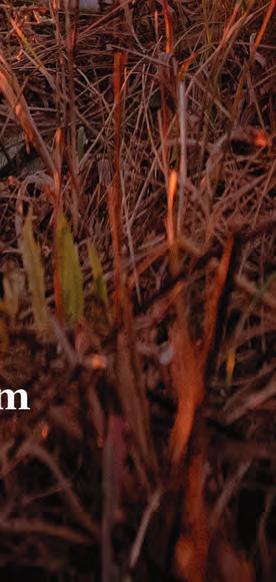



BY JONATHAN BOEDECKER



“The impossible happens all the time, just have to believe it can.”


Some people grew up watching the Robinson family in the original “Lost in Space” TV series, and some had their rst experience with it via the 1998 movie; then Net ix took a crack at it in 2018 with a new series and it felt like the story had nally found itself a new, modern-day home. With stunning visual e ects, new planets to crash on and a new kind of ... DANGER!




I always looked forward to seeing a second or third movie following the events of the 1998 release – but alas, it will never happen. e good news is that the Net ix version of “Lost in Space” has been wonderful.
e ve-member Robinson family is on their way to a new home on Alpha Centauri. Earth is doomed due to repeating disasters and inhabitants can earn a one-way trip to a new home planet – if they pass the tests, that is. Seasons 1 and 2 have been streaming for a few years, and then COVID hit and stopped production on quite a few projects. DANGER! DANGER! More good news: “Lost in Space” has found its way to produce Season 3 and it was released in December 2021.




I have to say that Season 3 gave the series a well done nish. During the three seasons, the Robinsons have a handful of adventures and must respond in the face of dangerous events. And, just like in real life, once you x one problem, another four problems appear that you have to work to solve.
Season 3 picks up just after the giant Season 2 cli hanger, but then jumps to a future time. Knowing that Season 3 would be the last in the series, Net ix had announced that fact when they were preparing to release it. It made me wonder whether anyone would be seriously hurt or worse, because that is kinda typical of nal seasons. But ... (spoiler alert) … kidding, I will not spoil it for you.

• The Batman
• Thor: Love and Thunder
• Top Gun: Maverick
• Jurassic World: Dominion
I feel that “Lost in Space” presents a good take on what living in space and traveling to a new planet would be like: a constantly nervewracking experience until you arrive at the new vacation spot. It is a good watch, family friendly and I give it four out of ve squirrels.

• Doctor Strange in the Multiverse of Madness
• Mission: Impossible 7
• Uncharted
• The Flash
• Morbius


• Fantastic Beasts: The Secrets of Dumbledore
• Spider-Man: Across the Spider-Verse (Part One)
• House of the Dragon
• The Lord of the Rings
• The Last of Us
• Obi-Wan Kenobi
• She-Hulk
• Ms. Marvel
• Moon Knight
• The Mandalorian Season 3
• Stranger Things Season 4
• The Boys Season 3


• Ozark Season 4 (Hopefully!)


Note: “Spider-Man: No Way Home” came to theaters on 12.17.2021. I had the chance to see it during the opening weekend and I think they did a very good movie for MCU’s third “Spidey” ick. If you have a chance to see it in-theater, I recommend it! ®









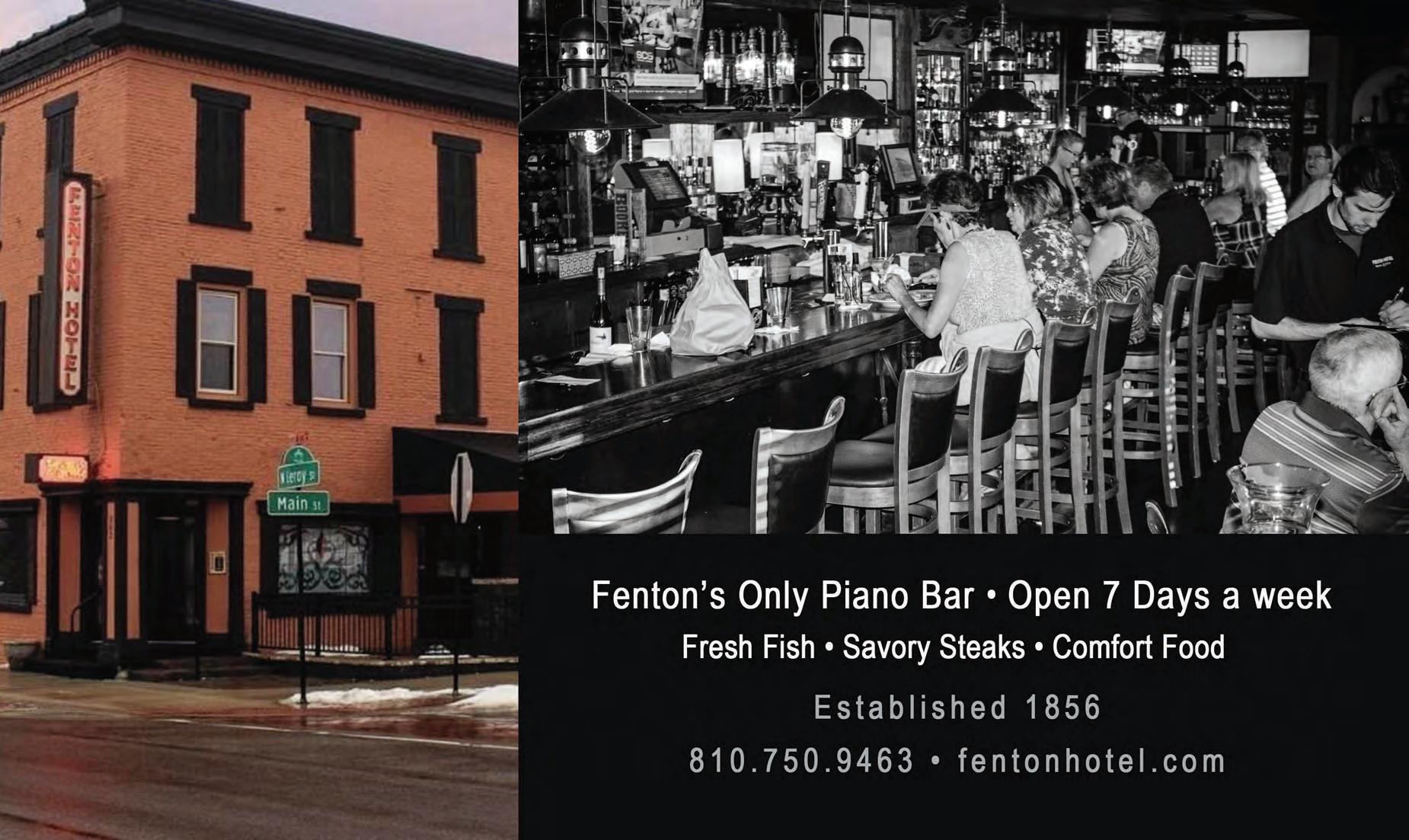
BY DR. CHRISTOPHER DOUGLAS
Ifthe 2021 economy could be summarized in one word, I would say it is “disappointing.” Vaccine development and deployment has far exceeded expectations since the pandemic began; anyone who wants a vaccine can get one! e economic recovery in the face of this, however, is far below expectations.
Gross domestic product (GDP), which is the value of all nal goods and services produced in the economy, remains $327 billion below potential. is means that the economy is producing $327 billion fewer goods and services than it could if all productive resources were utilized. is is especially disappointing, in that given the slow recovery following the Great Recession, GDP had only returned to potential in 2018, before falling signi cantly below it during the shutdown.
A big reason why GDP lags below potential is that many of the jobs lost during the shutdown have not yet returned. Prior to COVID, there were 152.5 million jobs in the economy. In November 2021, there were only 148.6 million. us, total employment is 3.9 million jobs lower than what it was in February 2020. Fewer people working means fewer goods and services produced. e reason for this is that there are 11 million job openings in the economy not being lled, a record high number. In a normal economy, there are roughly seven million job openings due to things like resignations, rings and new jobs being created. us, there are four million more job openings than what would normally be expected. If these surplus job openings were lled, employment would return to its pre-COVID level, labor market shortages would be resolved and GDP would return to potential. e reason these job openings are not being lled is that many workers who exited

the labor force during the shutdown have not yet returned. Labor force participation, which is the percentage of the population working or looking for work, has only regained half of its losses experienced during the shutdown. is is not the situation in Canada, where both total employment and labor force participation have returned to pre-COVID levels.
At 6.8% in November, in ation is at a 40-year high and is four times higher than pre-COVID levels. Various excuses have been made for the rising in ation, namely it was due to “base e ects” (e.g. prices quickly rising after falling during the shutdown) or that it is “transitory.” Now, both the Federal Reserve and Secretary of the Treasury have admitted that the in ation is not transitory and thus, is permanent. is should not have been a surprise to anyone, given that in ation comes from new money being created and then spent. is is what has happened over the past 22 months, with the money supply being doubled to fund three rounds of COVID relief plus other spending. If this goes on, in ation will continue.
With a safe and e ective vaccine being widely available, life should be returning to normal. e fact that this is not happening does not bode well for the future. ®

Dr. Christopher Douglas came to the University of Michigan-Flint in 2006. He earned a B.S. in Electrical Engineering and a B.S. in Economics from Michigan Technological University in 2001, and his Ph.D. in Economics from Michigan State University in 2007. As Associate Professor and Chair of the Department of Economics, he teaches Principles of Microeconomics, Principles of Macroeconomics, International Economics, Public Finance, and Sports Economics.












BY JOEL P. LAGORE, CFP®, AIF®
I also want to share some exciting news! e team at OLV Investment Group was recently joined by a new nancial advisor who has worked diligently in the nancial services industry for over 25 years. Tim St. Cin, formerly of Morgan Stanley Smith Barney, is someone we consider to be well-known in the Flint area and we are honored that he has chosen to nish his career with OLV Investment Group.
Now, on to the business of 2022. After a life-altering 18 months and watching our stadiums go from socially distant attendance to 100,000 U of M fans packed like sardines in e Big House, I’m beginning to think that life may just start getting back to normal. I know – we’re not getting our hopes up, as it seems like this virus can do the impossible; but a research article has got me excited. is research comes from a little rm out of New York City called JP Morgan Chase (Fortune.com Dec 9, 2021). It is their opinion that the Omicron variant of COVID-19 may be exactly what we need to be able to move forward. From all the leading information that we are getting back, this variant is signi cantly more transmissible, but has been much less deadly than the others. is could possibly be the magic ticket out of this hell in which we’ve all been living. If this COVID variant spreads like wild re and infects the masses while not killing many, we could possibly reach the ever-illusive “herd immunity.” is variant could be exactly what the U.S. needs to get back to normal life.
e implications of this outcome could be so positive, I don’t think we would know what to do with the amount of pent-up demand. Americans are known for being very “hardworking.” We love to work hard, be rewarded with extra income, promotions and accolades from our peers. My generation, Gen-X, is known as the “Work Hard, Play Harder” generation. I can tell you from my observations that there is a whole generation that has
buckled down under COVID-19 restrictions and poured their hearts and souls into their jobs as a way to keep their sanity. My work week has ramped up from an average 50 hours to a minimum of 60 and sometimes, even 70 hours. Many of my older clients who were intending to travel and see the world during their retirement have delayed those trips and saved that money in anticipation of spending it when life “gets back to normal.”
My point is that if the article from JP Morgan Chase proves correct, we could see one amazing economic boom in 2022 as America is desperate to get back to enjoying the spoils of our hard work and make up for lost time. is may seem like a pipedream for some; but hope is the belief in things not yet seen. Even the 1918 Spanish u took approximately three years to end. January 2022 marks the two-year anniversary of COVID-19 (CDC.gov) and one way or another, this is going to end. When the 11 trillion dollars of stimulus money is unleashed into the capital markets in a frenzy of excitement, this could be an economic boom the likes of which were only seen during the Roaring 20s. Wait … what? Yes, “happy days are here again” could be a reality. More on the uncanny comparisons of our current times to the 1920s in my next article.
Happy New Year, MCM Readers! Make 2022 Amazing! ®

Joel P. LaGore, Certified Financial Planner and partner with OLV Investment Group, focuses on money management. Joining the Downtown Flint revitalization effort, his office is located in The Durant at 607 E. Second Ave., Suite 100. Joel and his wife Sonya are raising two daughters in Flushing, where he enjoys philanthropic pursuits in his local community, in Flint at large and in Genesee County.




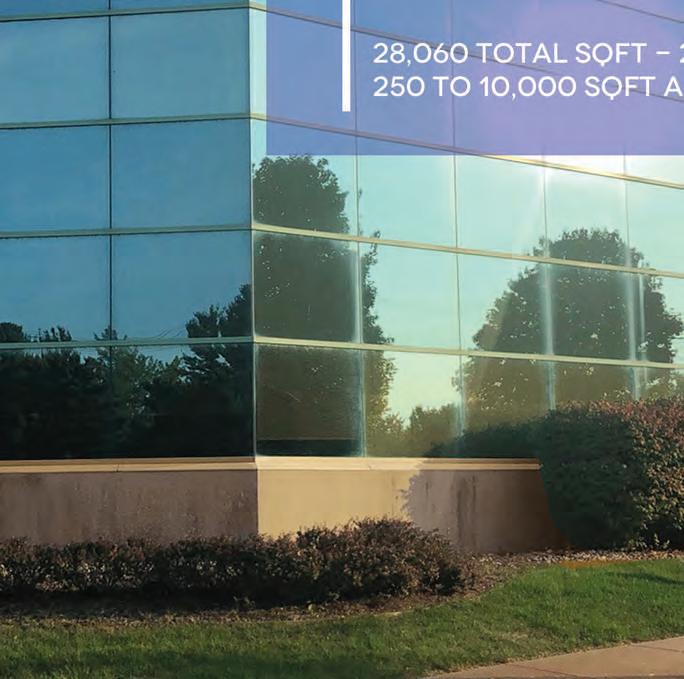








BY CHERYL DENNISON



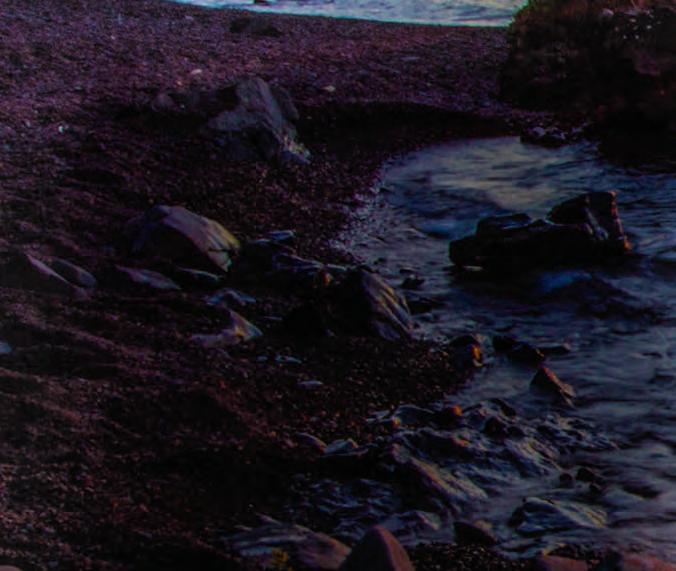
AsI look back and say good-bye to the year 2021, all I can say is it was a very interesting year. Although it began in turbulence with the January 6 insurrection at our nation’s Capitol building – an unsettling experience – and ended with terrifying tornadoes in Kentucky, it brought me some good personal experiences. Here are some highlights of my 2021.
I traveled to Maryland with my daughter and grandsons to attend my 50th high school class reunion. It was great to reconnect with many old friends and reminisce about old times. I also had a chance to see and talk to some of my siblings, a rst since the pandemic began. Visiting my sister, who lives in the home we grew up in, brought back many fond memories of fun summers in the mountains, horseback rides and barbecues. A trip to Maryland always includes eating steamed Maryland blue n crabs and enjoying a cup of crab soup at Kline’s Restaurant, something I look forward to every time I visit. Another highlight was visiting the cottage in Oscoda and watching the sunrise over Lake Huron. And gol ng on the Ladies League at Fenton Farms every ursday morning was an activity that made the year special.



Over Labor Day weekend, my daughter and I traveled to Houghton/Hancock in the U.P. to help my oldest grandson, a student at Michigan Technological University, set up his apartment. After a lot of hard work, Brennan took us on a tour of the school. We also drove up to Copper Harbor, which is well known for its rugged beauty.

e scenery there was breathtaking as the foliage was just hinting a change to fall colors. And, there is nothing more beautiful than driving along the coastline of Lake Superior on a sunny day. e view of the lake from Brockway Mountain was absolutely stunning.
In December, it was good to see the return of the holiday festivals in our area – Jinglefest in Fenton, Holiday Happening in Linden and the Dickens Festival in Holly. We took my ve-year-old grandson to the Jinglefest parade, one of the biggest ever, with marching bands from both Fenton and Lake Fenton high schools. It was so much fun watching the excitement on his face as he gathered candy from the street and watched all of the oats and re trucks pass by. A reworks display was the perfect ending to a perfect day.

I am looking forward to 2022 – a new year and new experiences. My grandson Mack will graduate from high school this year and leave home to serve our country as a U.S. Marine. It has been and will continue to be a bittersweet experience as I watch each grandchild grow up and move on. I also look forward to writing many more stories for My City Magazine, which allows me to meet many new people and share the great things that are happening in Greater Flint. e New Year also brings an opportunity to share a smile with someone, to lend a helping hand and maybe make a di erence in someone’s life. I plan to do just that – and to enjoy each and every day! ®





Those Dazzling Divas of Motown
The Pix Theatre – Lapeer
1.7-8.2022
Tantric
The Machine Shop
1.8.2022

Kitchener Rangers vs. Flint Firebirds
Dort Financial Center
1.12.2022
“The Secret Garden”
Flint Community Players
1.13-23.2022
Drumline Live
The Whiting
1.21.2022
15th Annual FIA
Community Gala
Flint Institute of Arts
1.22.2022

Soo Greyhounds vs. Flint Firebirds
Dort Financial Center 1.22.2022
Wreking Crue
The Machine Shop 1.22.2022
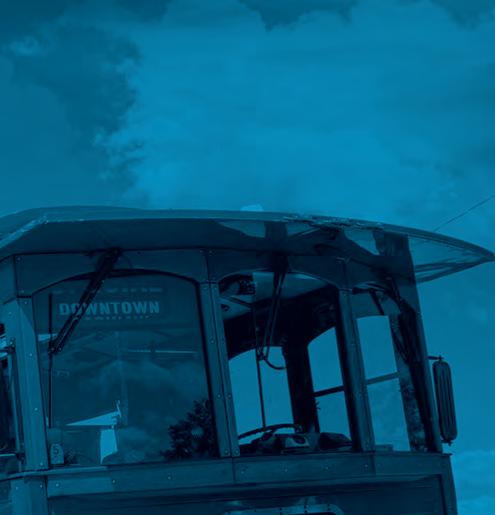
Zehnder’s Snowfest Frankenmuth 1.26-31.2022
Mark Farner’s American Band
The Capitol Theatre 1.28.2022
Sarnia Sting vs. Flint Firebirds
Dort Financial Center 1.29.2022

“Rabbit Hole”
Fenton Village Players
1.29-31.2022
See you there!

BY ALEXANDRIA NOLAN
There is so much about traveling that has changed since COVID-19 and all of its variants arrived on the scene.
Of course, there are the obvious di erences – the mask-wearing on airplanes and in many public attractions like museums, resorts and galleries. e reduced hospitality of the airlines, less samples being o ered, more automated everything to cut down the risk of disease transmission.
No matter where we have been during these past two years, if something is open, then it has reduced capacity or reservations must be made in advance, appointments scheduled, spontaneity discouraged. Stumble upon the New Orleans Pharmacy Museum in the French Quarter? Well, cross your ngers and hope that they have availability in the next 36 hours or so, or else you’re not visiting it. Impromptu tour of an historical home? Don’t think so; no reservation, no way. inking of hopping on a canal boat in Amsterdam to sight-see? Well, they’re at capacity due to new pandemic measures, so it looks like you’re walking.
Not that this is always so bad. If you have taken the time to make the reservations and save your place, you have a less crowded museum to enjoy. ere are fewer people milling about, fewer bodies to jostle with and maneuver around. Depending on the capacity of di erent places, you can virtually feel as if you have your own private exhibit or the attraction entirely to yourself. ere’s less opportunity for pickpockets at the Louvre and more room to breathe in the art gallery.
But it can be hard in other ways, as well. I notice, especially when traveling, that there’s a greater wariness of one another, a certain distrust. Is it because we cannot see each other’s faces anymore? Or is it because we aren’t sure who might be carrying the virus and so, want to avoid getting too close? I’m not completely certain, but there’s an invisible line between us that didn’t previously exist. Some of the connection we used to feel when sitting next to a party dining at a restaurant on the Amal Coast, or the camaraderie of sharing an elevator, or being crowded together at too-close cafe tables has turned to suspicion and tight expressions.
It’s becoming increasingly di cult to force a mask on my three-year-old. On one hand, I want him to be

safe and others around us to feel safe; but on the other, it makes me sad to see so much of his life hidden behind a mask. It’s become too familiar, in a way. We have a sort of sing-song mantra in our house as we get ready for an adventure. “What do we do when we ride on a plane?” I ask, “Wear a mask!” he responds immediately. Of course he travels much more often than most other children, but it’s hard to see him and other kids, and realize that they have seen more people with half their faces hidden than without. So much of travel is about knocking down boundaries, seeing that we have far more in common than we realize, and I grieve that at the moment, we aren’t seeing much.
Disease variants emerge and we change the way we travel, visit and live accordingly, to keep one another safe. We try to balance new restrictions with bucket lists and impromptu adventures with the need for reservations and capacity restrictions. We are trying to keep the world open without everything shutting down.
Travel looks a little di erent, but the need for connection and new vistas remains. We may not see all of one another’s faces, but hopefully, we can still glimpse a little of our hearts. ®

Alexandria Nolan is a misplaced Michigander living in Houston, TX with her husband, three pets and toddler son. She is a published author and contributor to various online and print publications, including a lifestyle blog, AlexandriaNolan.com. When not writing, she is reading, traveling, or reading about traveling.


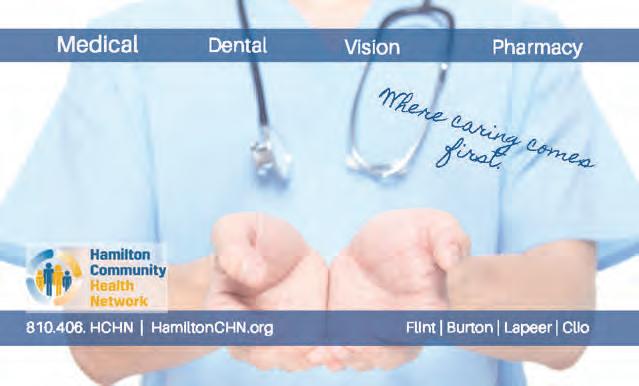





“Whatever it is you’re scared of doing, do it. Make your mistakes next year and forever.”
Neil Gaiman

BY PETER HINTERMAN
Aswe leave 2021 behind and enter the New Year, many of us spend time re ecting on our past year and vowing to make changes in our lives. Maybe some of us want to spend more time with family, start the business we’ve always dreamed of, eat better and be more active, etc. It isn’t something as simple as making a resolution; it’s a complete remodel of who we are, what we do and why we do it. As we open the day on January 1, we are ready to go. We make our lists, make our plans. And, in a few months or so, most of us nd ourselves right back in our regular routines –right back in the same rut we thought we left behind. Make this year di erent. Start and stick to your plans. Fight for the will to make things happen and make 2022 the beginning of the happier, better you.
“New year – a new chapter, new verse, or just the same old story? Ultimately, we write it. The choice is yours.”
Alex Morritt

“Your present circumstances don’t determine where you can go. They merely determine where you start.”
Nido Qubein
“Do not wait until the conditions are perfect to begin. Beginning makes the conditions perfect.”
Alan Cohen
“It is never too late to be what you might have been.”
George Eliot
“Hope smiles from the threshold of the year to come, whispering, ‘it will be happier’.”
Alfred Lord Tennyson
“And
now
we welcome the new year. Full of things that have never been.”
Rainer Maria Rilke
Make 2022 the start of something amazing. HAPPY NEW YEAR! ®









